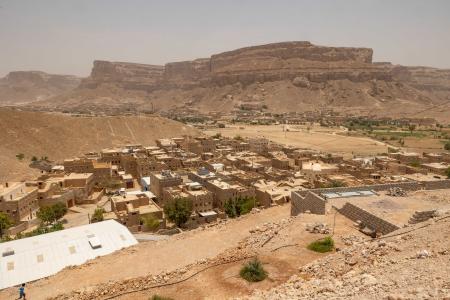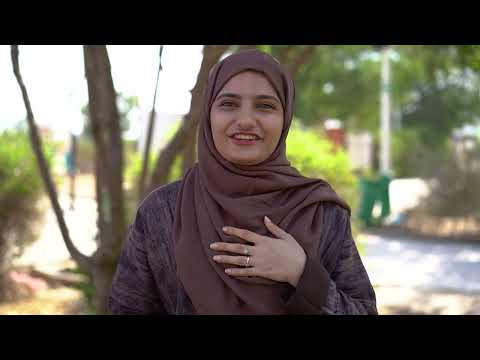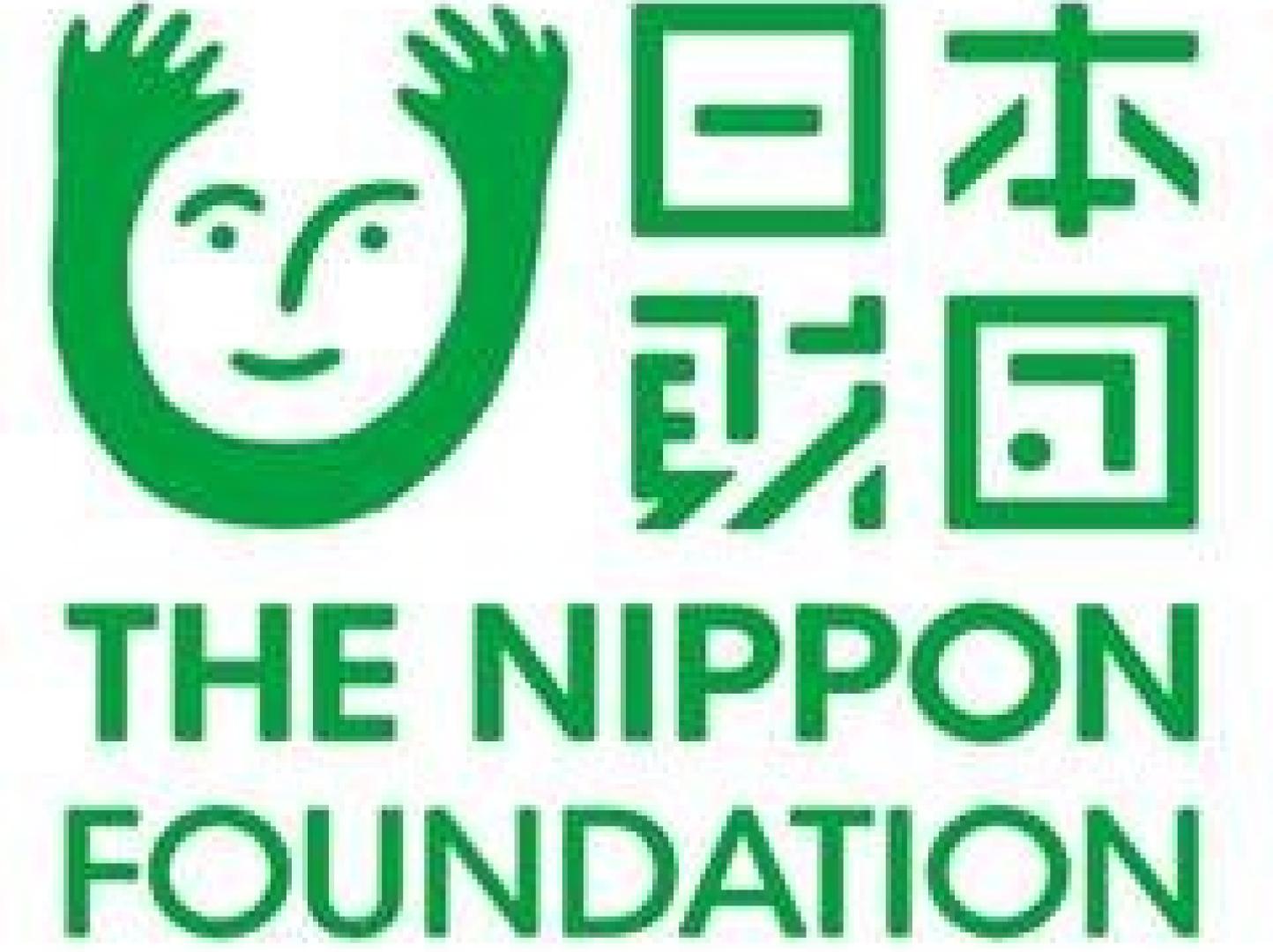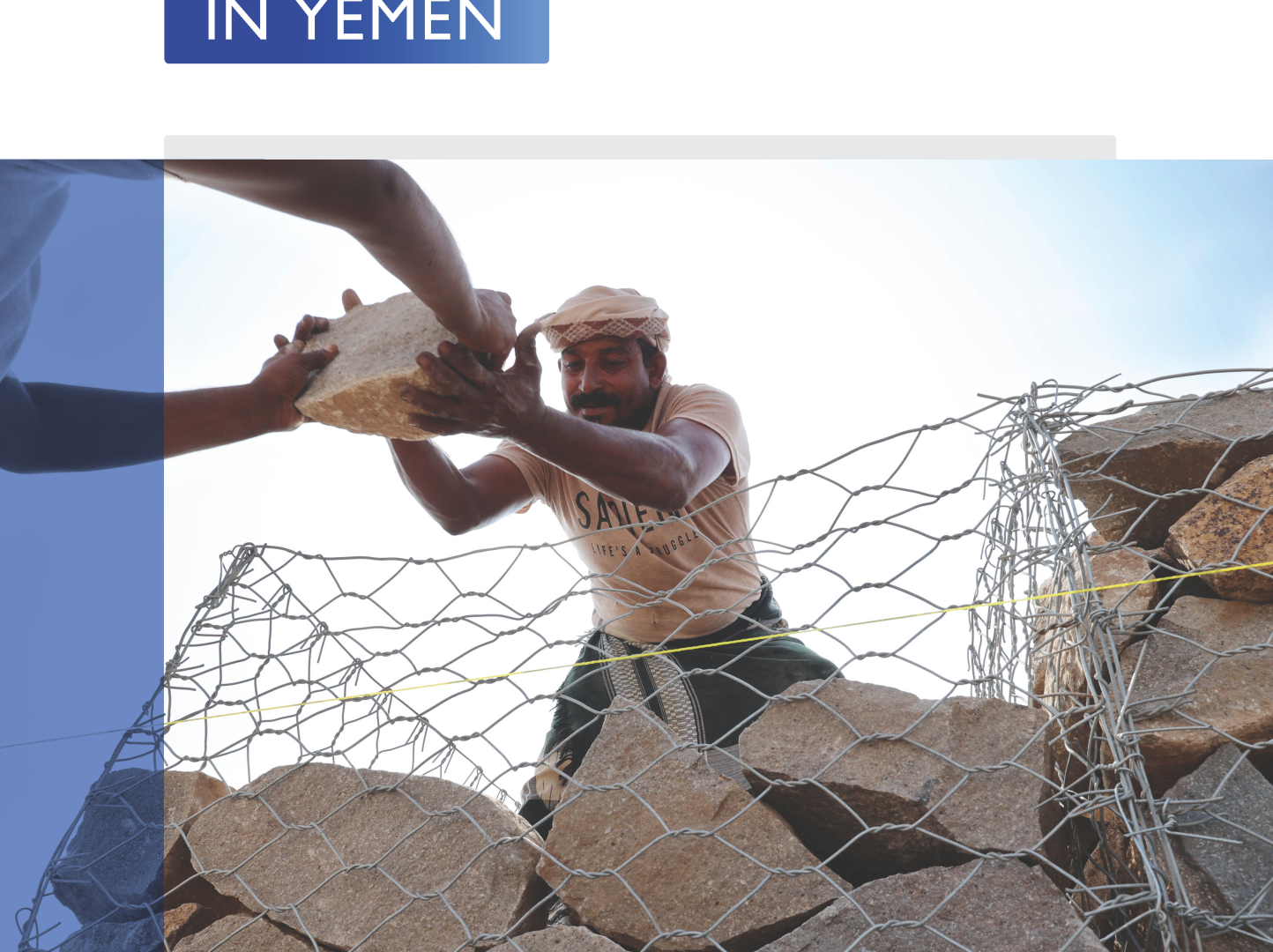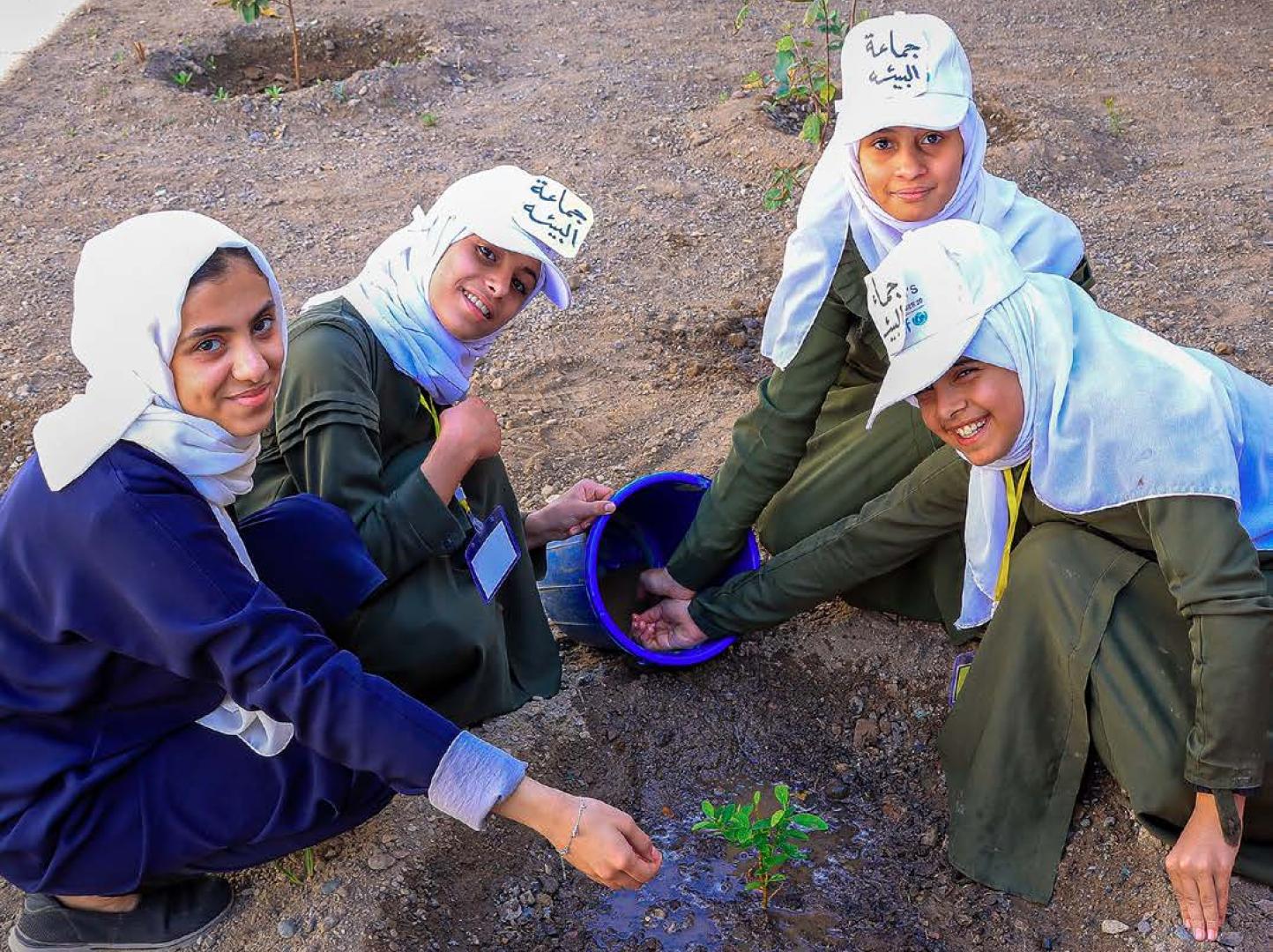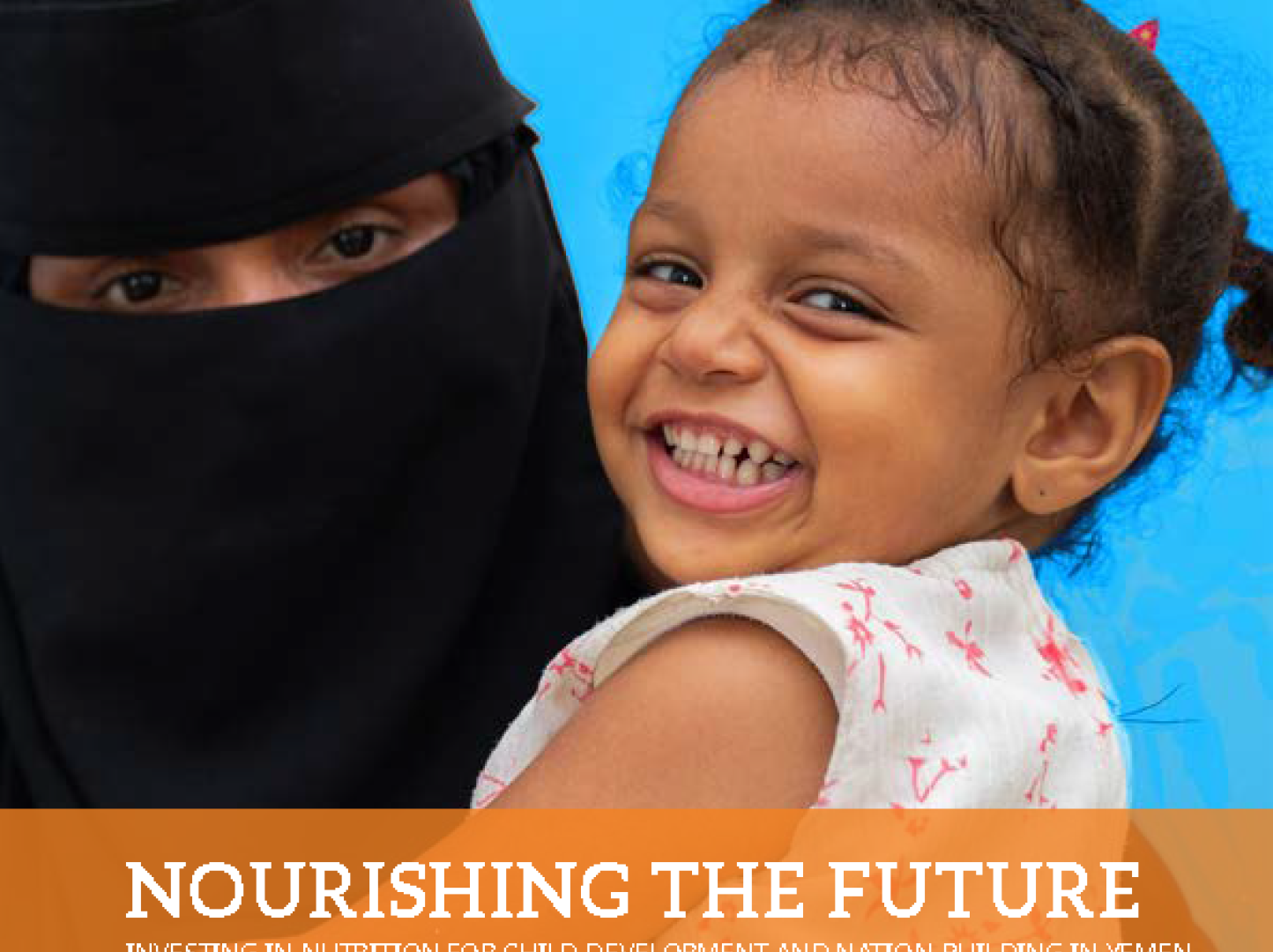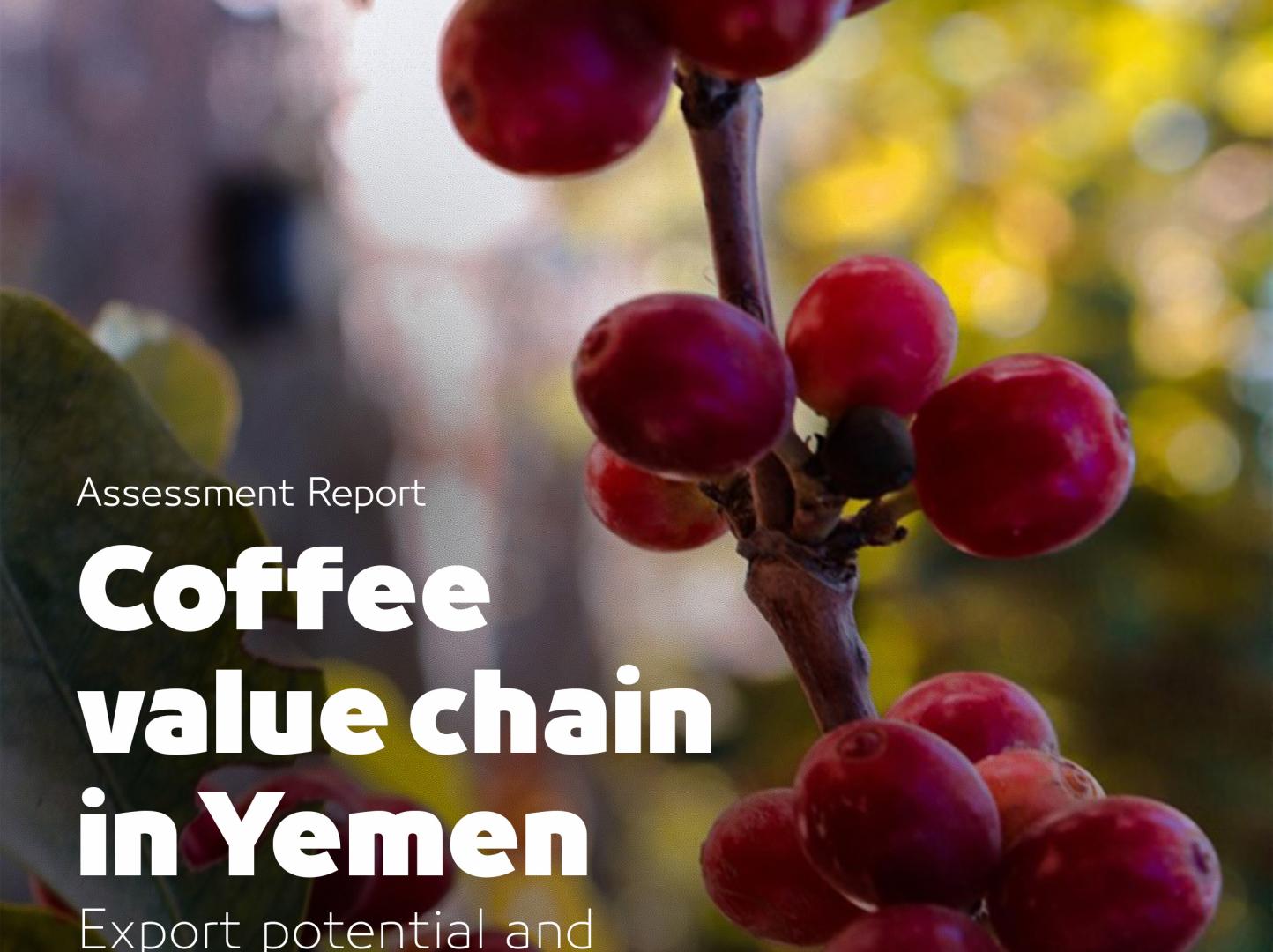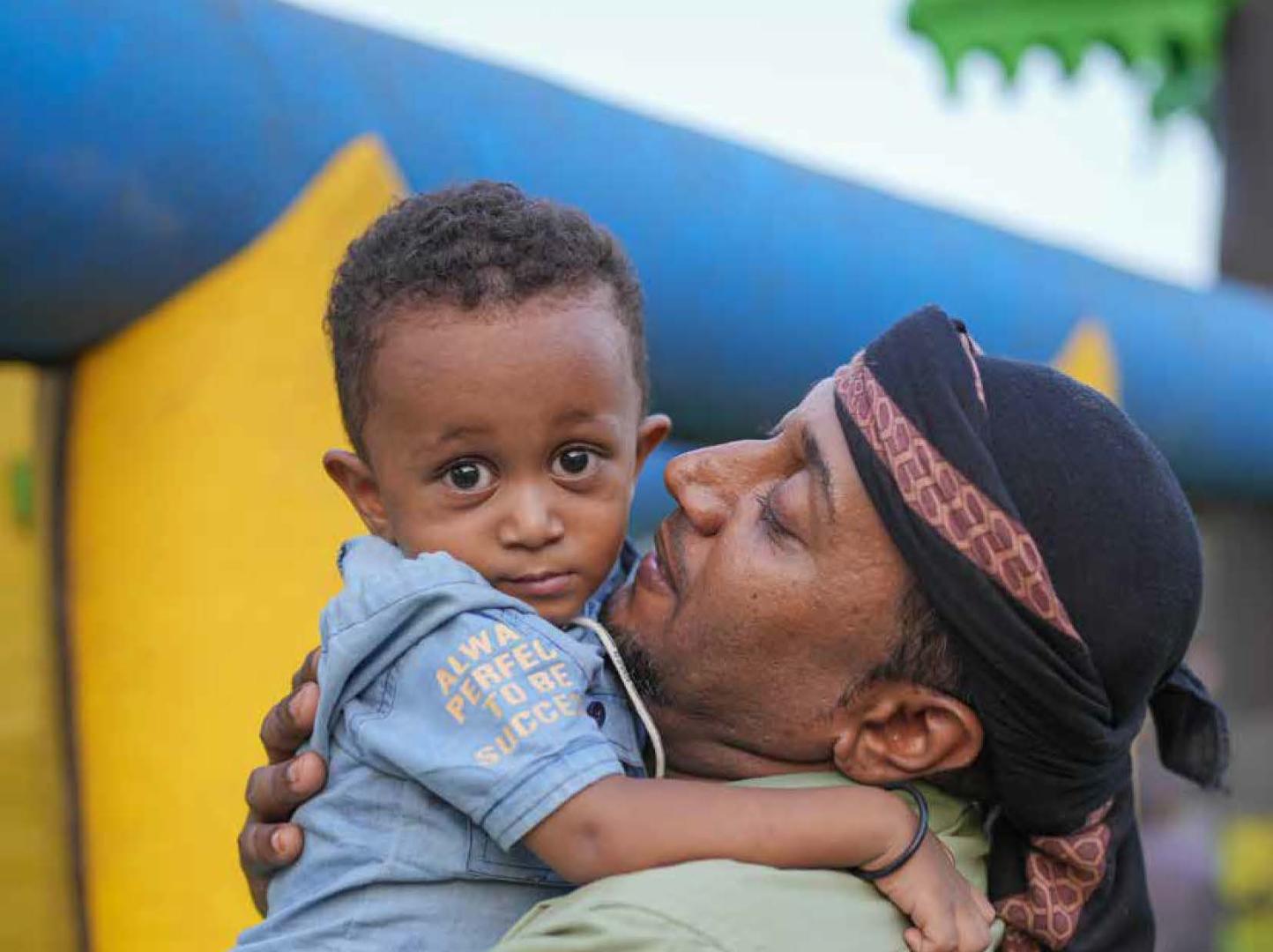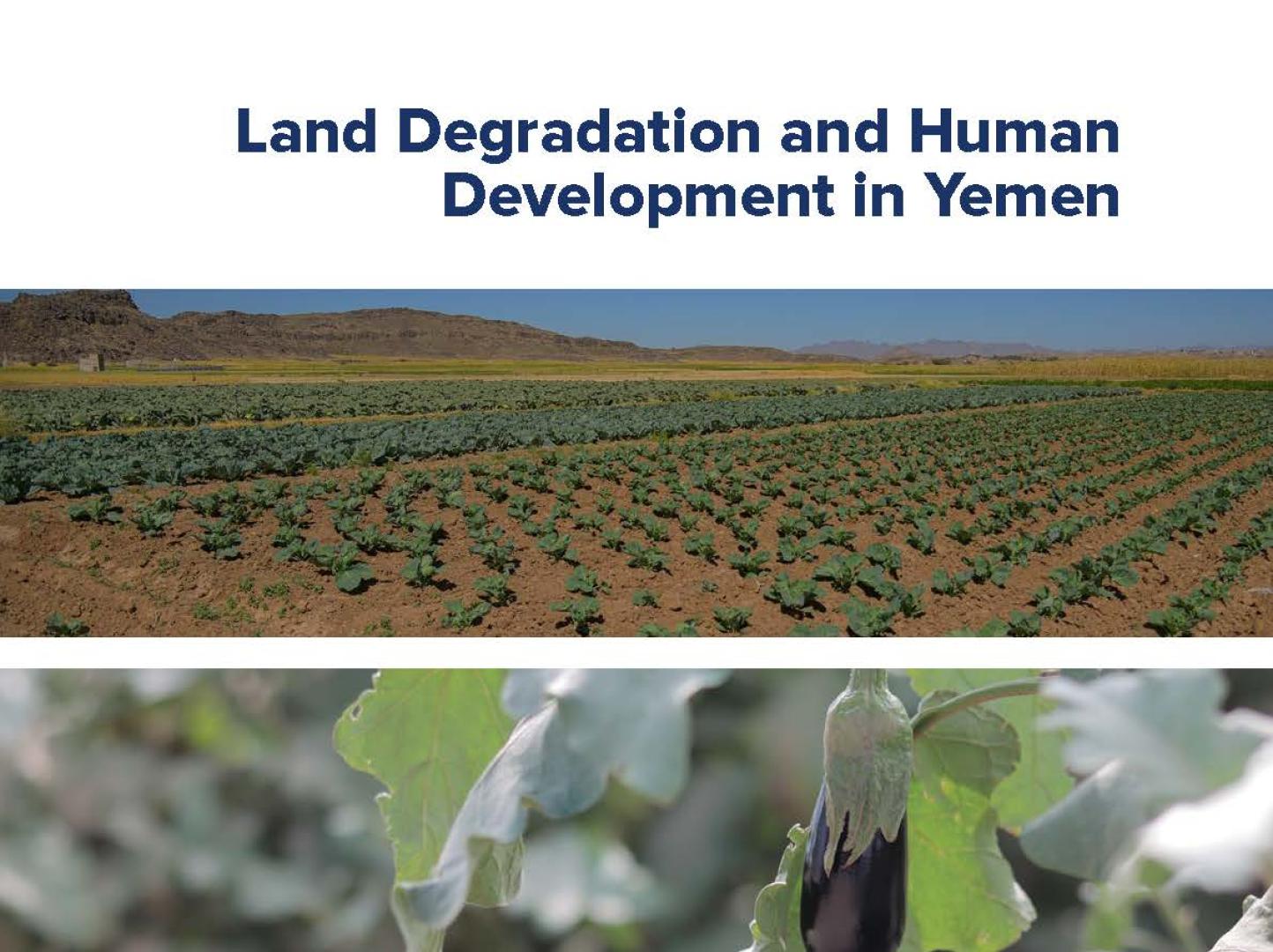Latest
Press Release
12 July 2025
WHO and UNICEF launch polio vaccination campaign targeting over 1.3 million children in Government of Yemen-controlled areas
Learn more
Speech
11 July 2025
THE SECRETARY-GENERAL -- MESSAGE FOR WORLD POPULATION DAY 2025
Learn more
Story
07 July 2025
UNDP Yemen: Marking Nearly a Decade of Building Community Resilience in Rural Yemen
Learn more
Latest
The Sustainable Development Goals in Yemen
The Sustainable Development Goals are a global call to action to end poverty, protect the earth’s environment and climate, and ensure that people everywhere can enjoy peace and prosperity. These are the goals the UN is working on in Yemen:
Publication
28 April 2025
UN Yemen Country Results Report 2024
This report highlights the resilience of the Yemeni people and the collaborative impact of the United Nations Country Team and its partners in 2024. Despite immense challenges, significant strides were made in delivering essential development support, strengthening local capacities, and fostering pathways towards stability.Understand how the UN addressed critical needs in food security, healthcare, education, and livelihoods, while strengthening governance and promoting inclusive solutions. Discover the importance of strategic partnerships, innovative approaches, and the unwavering commitment to sustainable development goals in the Yemeni context.Download the full report to learn more about the UN's activities, achievements, and ongoing dedication to supporting Yemen's journey towards a peaceful and prosperous future.
1 of 5
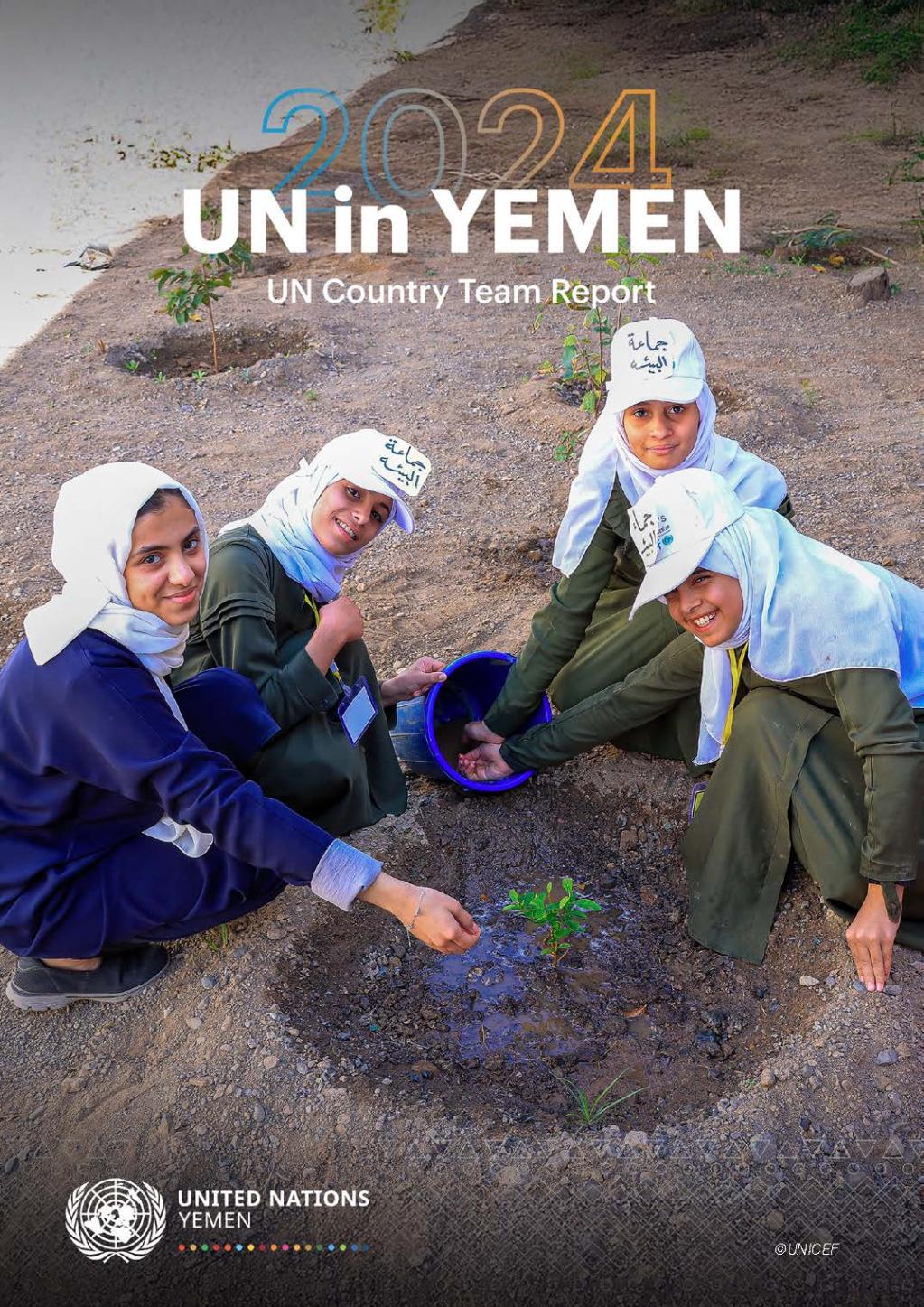
Press Release
05 September 2024
IOM Yemen: IOM Appeals for USD 13.3 Million to Help Hundreds of Thousands Affected by Yemen Floods
Yemen, 5 September – In response to the severe flooding and violent windstorms affecting nearly 562,000 people in Yemen, the International Organization for Migration (IOM) has launched a USD 13.3 million appeal to deliver urgent life-saving assistance. The unprecedented weather events have compounded the humanitarian crisis in the country, leaving thousands of internally displaced persons and host communities in dire need of assistance. “Yemen is facing yet another devastating chapter in its relentless crisis, exacerbated by the intersection of conflict and extreme weather events,” said Matt Huber, IOM Yemen’s Acting Chief of Mission. “IOM teams are on the ground, working around the clock to deliver immediate relief to families affected by this catastrophe. However, the scale of the destruction is staggering, and we urgently need additional funding to ensure that the most vulnerable are not left behind. We must act immediately to prevent further loss and alleviate the suffering of those impacted.” In recent months, torrential rains and flooding have destroyed homes, displaced thousands of families, and severely damaged critical infrastructure, including health centres, schools, and roads. Across multiple governorates, including Ibb, Sana’a, Ma’rib, Al Hodeidah, and Ta’iz, thousands of people have been left without shelter, clean water, or access to basic services, and scores of lives have been tragically lost. The storms have struck as the country grapples with a cholera outbreak and escalating food insecurity, further exacerbating the vulnerability of displaced families and strained health systems. As the harsh weather conditions are expected to continue, more households are at risk of displacement and exposure to disease outbreaks due to damaged water and health infrastructure. Ma’rib Governorate has been particularly hard-hit, with strong winds since 11 August severely damaging 73 displacement sites and affecting over 21,000 households. Public services, including electricity networks, have been severely affected, aggravating the crisis in one of Yemen’s most vulnerable regions. Urgent shelter repairs and cash assistance are needed, with healthcare services and sanitation infrastructure among the most immediate priorities. Since early August, floodwaters have damaged shelters, roads, water sources, and medical facilities, leaving over 15,000 families in Al Hodeidah and 11,000 in Ta’iz in desperate need of emergency support. These rains have not only led to tragic loss of life but have also wiped out entire communities’ belongings and means of survival. In response to this crisis, IOM is targeting 350,000 people with shelter, non-food items (NFI), cash-based interventions, health, camp coordination and camp management, and water, sanitation, and hygiene interventions. Distribution of water tanks, latrine repairs, and desludging efforts are ongoing in multiple sites, while health services are being expanded, with mobile teams currently treating over 100 individuals and referring critical cases to hospitals. IOM’s efforts are further supported by emergency response committees working tirelessly to register and verify affected households, relocate displaced families, and reduce the risks of further damage. However, the resources available are insufficient to cover the vast needs, with key gaps remaining, especially in the shelter and NFI sector. With no contingency stocks for essential relief items and the situation growing more critical by the day, immediate funding is necessary to address the most pressing needs on the ground. IOM stands ready to scale up its response but requires the necessary resources to do so. With further severe weather expected in the coming weeks and funding constraints, the Organization is urgently calling on the international community to support this appeal to continue providing lifesaving aid and address the overwhelming needs of those affected. To read the full appeal, please visit this page. For more information, please contact: In Yemen: Monica Chiriac, mchiriac@iom.int In Cairo: Joe Lowry, jlowry@iom.int In Geneva: Mohammedali Abunajela, mmabunajela@iom.int
1 of 5
Press Release
04 May 2023
Statement: Remarks at the pledging event for the FSO Safer operation co-hosted by the Netherlands and the United Kingdom
First, I want echo Achim’s thank you to the United Kingdom and the Netherlands for having organized this event.
And for contributing generously.
A third element that they both deserve credit for is recognizing early on the promise of a private-sector initiative to address the Safer which the Fahem Group and SMIT Salvage proposed in mid-2021 – a time when the previous UN plan to inspect the Safer was not moving.
The initiative called for a leading maritime salvage company to transfer the oil off the Safer and replace the decaying supertanker’s capacity.
That was the basis upon which the United Nations principals asked me to lead and coordinate UN system-wide efforts on the Safer, in September 2021.
In December 2021, United Nations senior management endorsed the UN-coordinated plan and asked UNDP to implement it, contingent upon donor funding.
In February 2021, I met with the Government of Yemen in Aden, which confirmed its support for the plan.
They have remained supportive ever since – as evidenced by a $5 million pledge that they made last year.
The Sana’a authorities had been favorable to the original initiative, but insisted that it be done under UN auspices.
In March 2022, they signed a memorandum of understanding with the UN that committed them to facilitating the operation.
A commitment that they continue to honor.
The agreement was also signed by myself with the Fahem Group, which has supported engagement in Sana’a on the initiative since 2021 on a voluntary basis.
By April 2022, the UN presented a draft operational plan to begin fundraising. The original budget for phase 1 and 2 was $144 million.
As Achim said, the Netherlands pledging event in The Hague last May brought in $33 million, which was a catalyst to move us to where we are today.
But finding funds to prevent a catastrophe proved far more difficult than finding money for a disaster.
In June, we launched a public crowdfunding campaign for the operation.
That has now brought in more than $250,000. More importantly, it captured media attention that galvanized further support for the plan.
In August, we received the first pledge from a private entity. $1.2 million from the HSA Group. The International Association of Oil and Gas Producers followed with a $10 million pledge and Trafigura Foundation with $1 million.
The private sector, we learned, was concerned about its liability linked to a contribution. UNDP, in particular, led the effort to resolve those issues of concern which gives us a basis for further private sector contributions.
By September last year, the UN met the target of $75 million to start the operation.
Unfortunately, even as UNDP was gearing up to begin, the cost of suitable replacement vessels surged, chiefly due to developments related to the war in Ukraine.
More money was also needed to start the initial phase because of the necessity to purchase a replacement vessel – also linked to the war in Ukraine as suitable vessels for lease were no longer available. The budget for the emergency phase – during which the oil will be transferred – is now $129 million. Most of the funding is now required up front in phase one. Now, the second phase only requires $19 million to complete the project.
So, the budget of $148 million is just $4 million more than was presented to donors a year ago.
Prior to today’s announcements, we had raised $99.6 million from member states, the private sector and the general public.
The general public has provided donations from $1 to $5,000.
The broad coalition working to prevent the catastrophe also includes environmental groups like Greenpeace and, in Yemen, Holm Akhdar.
Every part of the United Nations is involved, including the International Maritime Organization, the UN Environmental Progamme, and the World Food Progamme. The Office for the Coordination of Humanitarian Affairs is among those that have worked on the Safer file for years and has now ensured $20 million of bridging finance. That would need to be replenished by donor funding.
I also want to recognize the United States for playing a tireless role in mobilizing resources. It is among the top five donors, together with the Netherlands, Germany, the Kingdom of Saudi Arabia and the United Kingdom.
On 9 March, UNDP’s Administrator took the bold decision to purchase the replacement vessel Nautica – before all of the operation was in place.
That is because UNDP recognized the extraordinary problem and understood that the cost of inaction is too great, as Achim outlined.
UNDP also contracted the Boskalis subsidiary SMIT Salvage, which played an enormously helpful role in developing the UN plan long before it had a contract.
With both the Nautica and the SMIT vessel Ndeavor en route to Djibouti, we expect the operation to start before the end of the month.
Therefore, I thank all donors for the generous support, and we look forward to further generous support.
But the risk of disaster remains.
I am forever thankful to the heroic skeleton crew aboard the Safer that continues to do all it can to keep that vessel together until we can organize this salvage operation.
None of us will heave a sigh of relief until the oil is transferred.
And we will all heave a final sigh of relief when the critical second phase is completed. This requires that the project is fully funded as described.
As everyone has said we are just one step away so lets take the final step.
Thank you.
1 of 5
Publication
26 October 2022
UNITED NATIONS YEMEN SUSTAINABLE DEVELOPMENT COOPERATION FRAMEWORK 2022 – 2024
EXECUTIVE SUMMARY
UN global reform has elevated the United Nations Sustainable Development Cooperation Framework (UNSDCF) to be “the most important instrument for planning and implementing UN development activities” in the country. It outlines the UN development system’s contributions to reach the Sustainable Development Goals (SDGs) in an integrated way, with a commitment to leave no one behind, uphold human rights, Gender Equality and Women’s Empowerment (GEWE), and other international standards and obligations. The UNSDCF seeks to address the humanitarian, development and peace challenges in Yemen in an environment where key public institutions are fragmented, no national strategy exists, and where there has been no national budget since 2014. The Yemen UNSDCF outlines the UN’s collective priorities and development objectives to be reached jointly in the next three years 2022-2024 as part of an ongoing and longer- term vision for resilience building and forging of a pathway to peace.
Yemen is a country in conflict. The priorities of this UNSDCF are derived from the analysis of the impacts of this ongoing crisis on the people of Yemen, and the needs and opportunities as outlined in the UN’s Common Country Analysis (CCA) conducted in 2021.
The UN has prioritized four pillars that resonate with the SDG priorities of people, peace, planet and prosperity that aim, as a matter of urgency, to improve people’s lives in Yemen and build resilience that is equitable, inclusive, people-centred, gender responsive and human rights based, through outcomes that: 1. Increase food security, improving livelihood options, and job creation 2. Preserve inclusive, effective and efficient national and local development systems strengthening 3. Drive inclusive economic structural transformation 4. Build social services, social protection, and inclusion for all
The theory of change is driven by an expectation that by 2024 the impact for all people of all ages in Yemen affected by conflict, forced displacement and living in poverty in all its dimensions will experience change in the quality of their lives. This will be possible through increased food security and nutrition, livelihood options and job creation; preserved national and local development and systems strengthening; inclusive economic structural transformation and the building of social services, social protection and inclusion for all. Food security and nutrition, and sustainable and resilient livelihoods and environmental stability will be realized through effective food production and diversified food and nutrition security; and through sustainable climate sensitive environmental management. Rights-based good governance and inclusive gender sensitive improved public services and rule of law will be possible as a result of accountable, inclusive and transparent institutions and systems, as well as the building of trusted justice systems. Increased income security and decent work for women, youth and vulnerable populations will be realised through micro and macro-economic development and job creation. Strengthened social protection and basic social support service delivery focused on support to marginalized groups, and strengthening women and youth leadership in decision making processes will be supported through the preservation of social protection and expanded and effective social assistance and basic services.
The UNSDCF prioritises the population groups in Yemen that have the highest risk of being left behind due to the impact of conflict; economic, social, geographic or political exclusion; and marginalisation. Enacting the central transformative principle of the 2030 Agenda and the SDGs, whilst challenging in the Yemen context, does provide the lens through which the UNSDCF targets the most vulnerable and prioritise Leaving No One Behind.
On the basis that some groups in Yemen bear the brunt of the conflict due to forced displacement, livelihood disruption, food insecurity, limited social safety nets, increased levels of poverty and poor-
quality housing, the CCA 2021 identifies the following population groups at the greatest risk of being left behind:
- Women and girls - 73 percent of those displaced in Yemen are women and girls, especially women of reproductive age and adolescent girls
- Children – 60 percent of those killed directly by conflict are children under five
- Youth and adolescents – an estimated 2 million school-age girls and boys are out of school as poverty, conflict, and lack of opportunities disrupt their education
- Internally displaced persons – more than 4 million IDPs with 172,000 newly displaced in 2020 and almost 160,000 in 2021
- Refugees, asylum seekers and migrants – Yemen hosts approximately 138,000 migrants and 140,000 refugees and asylum seekers
- Persons with disabilities – 4.5 million Yemenis have at least one disability
- Ethnic and religious minorities – It is estimated that Muhamasheen represent 10 percent of the population living in marginalised conditions
The UNSDCF is comprised of four chapters. Chapter One: explores Yemen’s progress towards the 2030 Agenda through a detailed analysis of the country context drawing on the 2021 CCA. Chapter Two: presents the theory of change generally and per outcome area. Chapter Three: outlines the UNSDCF’s implementation plan focused on the management structure, resources, links to country programming instruments and Yemen’s Business Operations Strategy. Chapter Four: highlights the process for CCA updates, Monitoring and Evaluation and Learning. The Results Framework presents the outcomes and key performance indicators for monitoring agreed targets utilizing verifiable data sets. Two annexes capture the legal basis for all UN entities engaged in the UNSDCF and the mandatory commitments to Harmonised Approaches to Cash Transfers (HACT)1.
The UNSDCF represents the UN’s understanding that continued engagement in Yemen requires an operational architecture under-pinned by the Business Operations Strategy (BOS) and an integrated set of achievable programming priorities. These two strategic approaches of the UN system strengthen and make more inclusive the country’s national and local governance structures, and mainstream the required responses to the economic and health consequences of COVID-19. They tackle food insecurity and nutrition as a matter of priority and integrate the promotion and advancement of gender equality and women’s and girl’s empowerment.
UN global reform has elevated the United Nations Sustainable Development Cooperation Framework (UNSDCF) to be “the most important instrument for planning and implementing UN development activities” in the country. It outlines the UN development system’s contributions to reach the Sustainable Development Goals (SDGs) in an integrated way, with a commitment to leave no one behind, uphold human rights, Gender Equality and Women’s Empowerment (GEWE), and other international standards and obligations. The UNSDCF seeks to address the humanitarian, development and peace challenges in Yemen in an environment where key public institutions are fragmented, no national strategy exists, and where there has been no national budget since 2014. The Yemen UNSDCF outlines the UN’s collective priorities and development objectives to be reached jointly in the next three years 2022-2024 as part of an ongoing and longer- term vision for resilience building and forging of a pathway to peace.
Yemen is a country in conflict. The priorities of this UNSDCF are derived from the analysis of the impacts of this ongoing crisis on the people of Yemen, and the needs and opportunities as outlined in the UN’s Common Country Analysis (CCA) conducted in 2021.
The UN has prioritized four pillars that resonate with the SDG priorities of people, peace, planet and prosperity that aim, as a matter of urgency, to improve people’s lives in Yemen and build resilience that is equitable, inclusive, people-centred, gender responsive and human rights based, through outcomes that: 1. Increase food security, improving livelihood options, and job creation 2. Preserve inclusive, effective and efficient national and local development systems strengthening 3. Drive inclusive economic structural transformation 4. Build social services, social protection, and inclusion for all
The theory of change is driven by an expectation that by 2024 the impact for all people of all ages in Yemen affected by conflict, forced displacement and living in poverty in all its dimensions will experience change in the quality of their lives. This will be possible through increased food security and nutrition, livelihood options and job creation; preserved national and local development and systems strengthening; inclusive economic structural transformation and the building of social services, social protection and inclusion for all. Food security and nutrition, and sustainable and resilient livelihoods and environmental stability will be realized through effective food production and diversified food and nutrition security; and through sustainable climate sensitive environmental management. Rights-based good governance and inclusive gender sensitive improved public services and rule of law will be possible as a result of accountable, inclusive and transparent institutions and systems, as well as the building of trusted justice systems. Increased income security and decent work for women, youth and vulnerable populations will be realised through micro and macro-economic development and job creation. Strengthened social protection and basic social support service delivery focused on support to marginalized groups, and strengthening women and youth leadership in decision making processes will be supported through the preservation of social protection and expanded and effective social assistance and basic services.
The UNSDCF prioritises the population groups in Yemen that have the highest risk of being left behind due to the impact of conflict; economic, social, geographic or political exclusion; and marginalisation. Enacting the central transformative principle of the 2030 Agenda and the SDGs, whilst challenging in the Yemen context, does provide the lens through which the UNSDCF targets the most vulnerable and prioritise Leaving No One Behind.
On the basis that some groups in Yemen bear the brunt of the conflict due to forced displacement, livelihood disruption, food insecurity, limited social safety nets, increased levels of poverty and poor-
quality housing, the CCA 2021 identifies the following population groups at the greatest risk of being left behind:
- Women and girls - 73 percent of those displaced in Yemen are women and girls, especially women of reproductive age and adolescent girls
- Children – 60 percent of those killed directly by conflict are children under five
- Youth and adolescents – an estimated 2 million school-age girls and boys are out of school as poverty, conflict, and lack of opportunities disrupt their education
- Internally displaced persons – more than 4 million IDPs with 172,000 newly displaced in 2020 and almost 160,000 in 2021
- Refugees, asylum seekers and migrants – Yemen hosts approximately 138,000 migrants and 140,000 refugees and asylum seekers
- Persons with disabilities – 4.5 million Yemenis have at least one disability
- Ethnic and religious minorities – It is estimated that Muhamasheen represent 10 percent of the population living in marginalised conditions
The UNSDCF is comprised of four chapters. Chapter One: explores Yemen’s progress towards the 2030 Agenda through a detailed analysis of the country context drawing on the 2021 CCA. Chapter Two: presents the theory of change generally and per outcome area. Chapter Three: outlines the UNSDCF’s implementation plan focused on the management structure, resources, links to country programming instruments and Yemen’s Business Operations Strategy. Chapter Four: highlights the process for CCA updates, Monitoring and Evaluation and Learning. The Results Framework presents the outcomes and key performance indicators for monitoring agreed targets utilizing verifiable data sets. Two annexes capture the legal basis for all UN entities engaged in the UNSDCF and the mandatory commitments to Harmonised Approaches to Cash Transfers (HACT)1.
The UNSDCF represents the UN’s understanding that continued engagement in Yemen requires an operational architecture under-pinned by the Business Operations Strategy (BOS) and an integrated set of achievable programming priorities. These two strategic approaches of the UN system strengthen and make more inclusive the country’s national and local governance structures, and mainstream the required responses to the economic and health consequences of COVID-19. They tackle food insecurity and nutrition as a matter of priority and integrate the promotion and advancement of gender equality and women’s and girl’s empowerment.
1 of 5
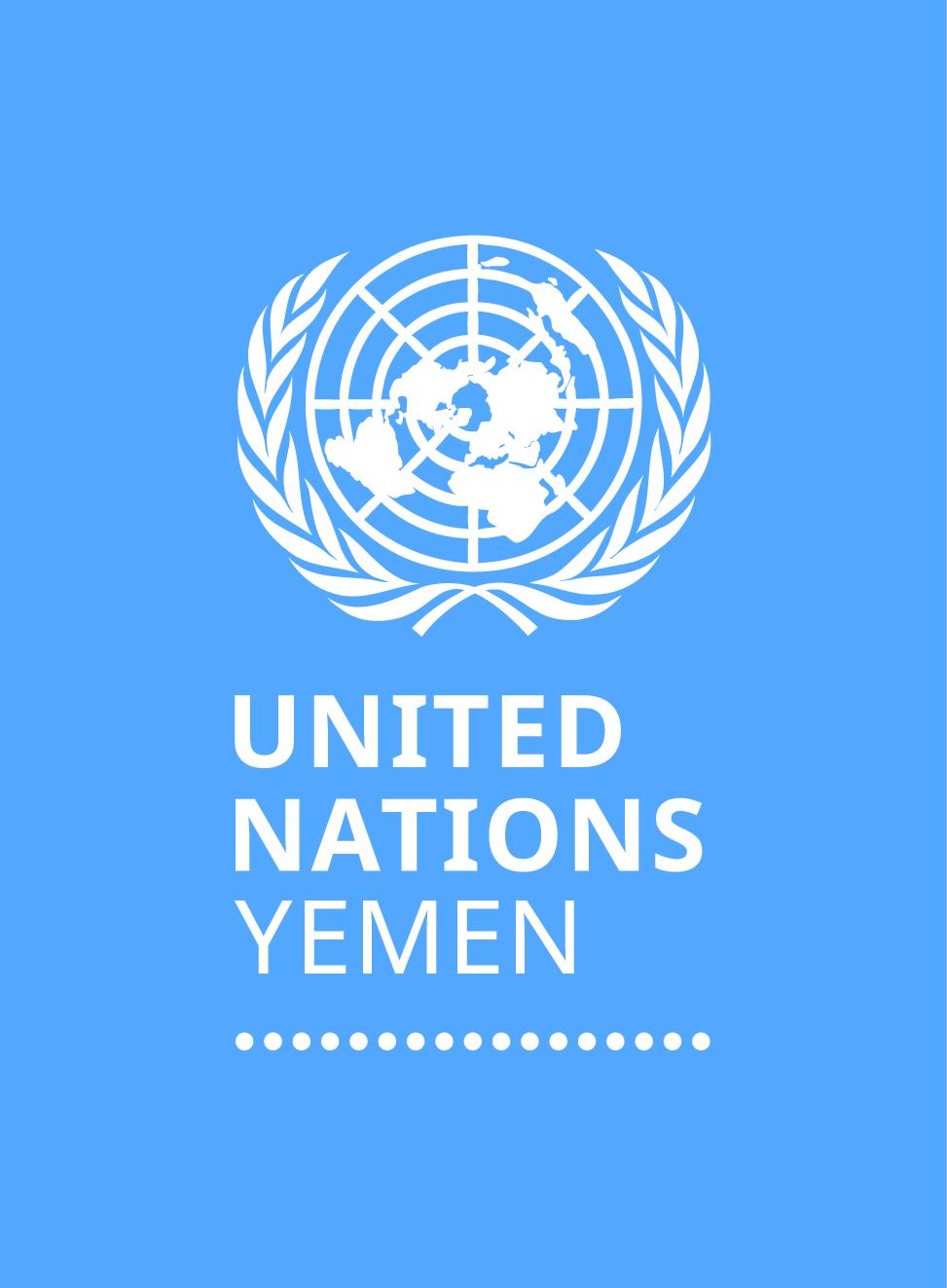
Press Release
15 August 2024
UNFPA/UNICEF Yemen: Life-saving aid critical as torrential rain sparks deadly floods across Yemen
Sana’a, 15 August 2024As relentless rain and catastrophic flooding in Yemen continue to exacerbate the suffering of families grappling with the impacts of poverty, hunger and protracted conflict, UNFPA, the United Nations Population Fund and UNICEF, the United Nations Children’s Fund, are delivering life-saving aid to some of the most vulnerable individuals through the Rapid Response Mechanism (RRM). With torrential rains forecast to continue into September, US$4.9 million is urgently needed to scale up the emergency response. Exceptionally heavy seasonal rains have caused flash floods in Yemen which are wreaking havoc in different parts of the country – the governorates of Al Hodeidah, Hajjah, Sa’ada, and Taizz are among the hardest-hit. Homes, shelters, and belongings have been swept away. Since early August, more than 180,000 people have been affected – over 50,000 people have been displaced in Al Hodeidah alone – a figure that is likely to rise in the coming days. Within 72 hours of the floods, over 80,000 people in flood-affected governorates had received emergency relief through the RRM, including ready to eat food rations, hygiene items, and women’s sanitary products. These items offer some immediate relief from the hardships caused by these catastrophic events. “The devastating floods have increased people’s needs, which are tremendous,” said Enshrah Ahmed, UNFPA Representative to Yemen. “Our RRM teams are working round the clock to provide immediate relief to affected families, but with rising needs and severe weather conditions forecasted, the coming weeks and months will be critical to ensuring affected families can pick themselves up and, at the very least, recover their lives.” In 2024, an estimated 82 percent of people supported through the RRM have been severely affected or displaced by climate-related shocks. As a result of the unseasonal levels of rain, the RRM cluster has had to spring into action, overstretching RRM teams, and depleting available supplies and resources. As needs continue to rise, RRM teams are struggling to reach affected families due to damaged roads, the erosion of landmines and unexploded ordnance from frontline to civilian areas. Items included in the RRM package are also in short supply. “The situation in the flooded areas is devastating. UNICEF and partners are on the ground providing urgently needed support to those impacted. The role of the Rapid Response Teams is critical in times of distress such as this one,” said Peter Hawkins, UNICEF Representative to Yemen.The RRM in Yemen was established in 2018 to provide a minimum package of immediate, critical life-saving assistance during human-made or natural disasters to newly displaced persons, and people in displacement sites or hard-to-reach areas, until the first line cluster response kicks in. The RRM ensures the distribution of immediate, ready-to-eat rations, basic hygiene kits provided by UNICEF, and women’s sanitary items provided by UNFPA, within 72 hours of a displacement alert. *** For more information, please contact UNFPA Taha Yaseen: Tel. +967 712 224090; yaseen@unfpa.org Lankani Sikurajapathy: Tel. +94773411614; sikurajapathy@unfpa.org UNICEF Kamal Al-Wazizah: Tel. +967 712 223 06; kalwazizah@unicef.org
1 of 5
Story
07 July 2025
UNDP Yemen: Marking Nearly a Decade of Building Community Resilience in Rural Yemen
For nearly a decade, the Enhanced Rural Resilience in Yemen (ERRY) Joint Programme has provided programming to bolster resilience and build back better in Yemen’s most vulnerable rural communities. Spanning three progressive phases from 2016 to 2025, ERRY programming was implemented across 37 districts in eight governorates, and reaching more than 2.1 million people through direct and indirect interventions.Funded by the European Union and the Government of Sweden, and implemented through a partnership of the United Nations Development Programme (UNDP), the Food and Agriculture Organization of the United Nations (FAO), the World Food Programme (WFP), and the International Labour Organization (ILO), the ERRY Joint Programme combined humanitarian assistance, development programming, and peacebuilding into one cohesive and community-centered approach.“The European Union has stood by the Yemeni people through the ERRY Joint Programme for nearly a decade - dedicating efforts not only to recovery, but to resilience, livelihoods, and long-term peacebuilding,” said Gabriel Munuera Vinals, EU Ambassador to Yemen.Anna Guittet, Counsellor and Regional Programme Manager for Yemen at the Embassy of Sweden, echoed this vision: "Sweden is proud to have supported a programme that empowers local communities and institutions to lead their own recovery. ERRY reflects our belief that lasting resilience must come from within."
Improving food security and agricultural resilience In the face of Yemen’s widespread food insecurity, the ERRY joint programme tackled both immediate hunger and long-term agricultural sustainability. Over 32,000 families received food support through food assistance for assets (FFA) while rehabilitating essential community infrastructure such as irrigation canals, feeder roads, water catchments, and agricultural terraces.To boost food production and restore rural livelihoods, the programme supported 42,500 farmers with improved seeds, tools, and inputs, and provided 47,550 livestock keepers with feed and veterinary care. Additionally, 34,900 farmers were trained in climate-resilient agricultural practices, including organic fertilization, crop diversification, and livestock fattening.In the dairy sector, 9,848 mostly women producers were supported, with the establishment of 10 dairy collection centers and 10 food processing facilities that enhanced both income and nutrition. As a result, the percentage of households in targeted areas reporting acceptable food consumption increased from 26% to 53%.“Before, I couldn’t afford to grow watermelon - diesel was too expensive, and the plants kept dying,” said Hussam, a 54-year-old farmer from Lahj. “Now, with the drip irrigation system and solar-powered pump I received, everything has changed. I’m growing more, spending less, and even expanding to new land. It brought my farm - and my hope - back to life.” Restoring livelihoods and economic opportunities The ERRY Joint Programme helped shift communities away from aid dependency by enabling them to generate their own income. More than 10,900 small businesses were launched, 45% of them led by women. Additionally, 7,000 youth received technical and vocational training in areas such as solar energy, mobile phone repair, tailoring, and appliance maintenance.These efforts yielded fast and tangible outcomes: 70% of new businesses reported results within three months, and 72% of families reported that they had developed a sustainable source of income.“The support I received through the ERRY Joint Programme turned my dream into reality. With my own camera, I’m not just taking photos—I’m telling stories, earning an income, and helping support my family,” says Abeer, a young photographer from Al-Maafer District, Taiz Governorate. Empowering women as economic and social leaders Beyond supporting thousands of women-led businesses, the ERRY Programme provided more than 12,500 women with training and financial support to launch sustainable income-generating activities. Around 2,800 women received agricultural inputs and equipment, enabling them to participate fully in local food production.Women were also active in local governance and peacebuilding. They accounted for 40% of all participants in community planning and dialogue processes, and 3,950 contributed directly to the development of local resilience plans. More than 100 women were trained as community mediators and trainers.“What motivates me is people’s suffering. When we work together, we can overcome anything—and build a better future for all,” said Rawda, a community coordinator in Al-Ma’afer, Taiz, who led local development across 40 villages. Expanding access to clean energy and climate-smart solutions To address energy poverty and climate vulnerability, the ERRY Programme installed 565 solar energy systems in schools, health centers, and vocational training institutes in Yemen. Twelve solar-powered irrigation schemes were introduced, along with two larger renewable energy plants — one solar-powered desalination unit and one hybrid solar-wind station.To ensure long-term maintenance, 100 staff were trained in solar system operation. ERRY also helped create a clean energy market by supporting 700 small energy enterprises and certifying 128 solar technicians. Furthermore, 7,000 farmers were trained in climate-smart agriculture and water management, while 1,000 households received drought-tolerant seeds.“With the solar system, everything is easier—the pumps work smoothly, the costs are lower, and people finally have clean water. This project didn’t just solve a problem; it transformed our daily lives.” Ahmed, Operation and Maintenance Officer, Al Maqaterah District, Lahj Governorate. Reinforcing local governance and access to basic services Strengthening community leadership was at the core of the ERRY Programme’s resilience model. A total of 811 village cooperative councils and 107 sub-district committees were activated and trained to lead local planning. These bodies developed 918 community resilience plans prioritizing development needs.The programme rehabilitated 1,585 community infrastructure projects — including schools, roads, water systems, and health facilities — many through cash-for-work and food-for-assets schemes. These efforts led to 85% of beneficiaries reporting improved access to basic services.Over 8,200 committee members, nearly half of them women, were trained in planning, coordination, and project management.“Before this project, we had no real health unit- just a room used by the school guard. Now, we have a proper facility with essential tools, allowing us to serve mothers and children in our community and reduce their need to travel far for care,” says Hanan Saleh, a community health volunteer at the rehabilitated health unit in Lawder District, Abyan Governorate. Promoting social cohesion and local peacebuilding Given Yemen’s protracted conflict and the current internal displacement of thousands of families, ERRY invested in grassroots peacebuilding. The programme trained 1,046 local mediators in conflict resolution, organized 265 dialogue sessions, and supported 81 community-led peace projects.These efforts contributed to a 70% increase in community cohesion and trust, according to local councils and civil society organizations. ERRY also facilitated over 1,000 self-led initiatives that addressed local priorities — from infrastructure repair to conflict prevention.“I was shy and hesitant to speak, even in front of women, but with the training I received through the programme, I gained the skills to communicate, negotiate, and build cohesion across dividing lines,”says Faten, reflecting on how the ERRY Joint Programme empowered her as an insider mediator in Bani Amer Village, Lahj Governorate. Leaving a lasting impactWhile the ERRY Joint Programme formally ended in June 2025, the systems, skills, and services it helped build remain embedded in the communities it served - offering a foundation for a more resilient and peaceful Yemen.“UNDP is grateful to the European Union and Government of Sweden for their partnership to enhance food security, livelihoods opportunities, renewable energy usage, and inclusive governance across vulnerable communities in Yemen,” said Zena Ali Ahmad, UNDP Yemen Resident Representative. Learn more about ERRY Joint Programme resilience efforts through visiting The Impact Report.
Improving food security and agricultural resilience In the face of Yemen’s widespread food insecurity, the ERRY joint programme tackled both immediate hunger and long-term agricultural sustainability. Over 32,000 families received food support through food assistance for assets (FFA) while rehabilitating essential community infrastructure such as irrigation canals, feeder roads, water catchments, and agricultural terraces.To boost food production and restore rural livelihoods, the programme supported 42,500 farmers with improved seeds, tools, and inputs, and provided 47,550 livestock keepers with feed and veterinary care. Additionally, 34,900 farmers were trained in climate-resilient agricultural practices, including organic fertilization, crop diversification, and livestock fattening.In the dairy sector, 9,848 mostly women producers were supported, with the establishment of 10 dairy collection centers and 10 food processing facilities that enhanced both income and nutrition. As a result, the percentage of households in targeted areas reporting acceptable food consumption increased from 26% to 53%.“Before, I couldn’t afford to grow watermelon - diesel was too expensive, and the plants kept dying,” said Hussam, a 54-year-old farmer from Lahj. “Now, with the drip irrigation system and solar-powered pump I received, everything has changed. I’m growing more, spending less, and even expanding to new land. It brought my farm - and my hope - back to life.” Restoring livelihoods and economic opportunities The ERRY Joint Programme helped shift communities away from aid dependency by enabling them to generate their own income. More than 10,900 small businesses were launched, 45% of them led by women. Additionally, 7,000 youth received technical and vocational training in areas such as solar energy, mobile phone repair, tailoring, and appliance maintenance.These efforts yielded fast and tangible outcomes: 70% of new businesses reported results within three months, and 72% of families reported that they had developed a sustainable source of income.“The support I received through the ERRY Joint Programme turned my dream into reality. With my own camera, I’m not just taking photos—I’m telling stories, earning an income, and helping support my family,” says Abeer, a young photographer from Al-Maafer District, Taiz Governorate. Empowering women as economic and social leaders Beyond supporting thousands of women-led businesses, the ERRY Programme provided more than 12,500 women with training and financial support to launch sustainable income-generating activities. Around 2,800 women received agricultural inputs and equipment, enabling them to participate fully in local food production.Women were also active in local governance and peacebuilding. They accounted for 40% of all participants in community planning and dialogue processes, and 3,950 contributed directly to the development of local resilience plans. More than 100 women were trained as community mediators and trainers.“What motivates me is people’s suffering. When we work together, we can overcome anything—and build a better future for all,” said Rawda, a community coordinator in Al-Ma’afer, Taiz, who led local development across 40 villages. Expanding access to clean energy and climate-smart solutions To address energy poverty and climate vulnerability, the ERRY Programme installed 565 solar energy systems in schools, health centers, and vocational training institutes in Yemen. Twelve solar-powered irrigation schemes were introduced, along with two larger renewable energy plants — one solar-powered desalination unit and one hybrid solar-wind station.To ensure long-term maintenance, 100 staff were trained in solar system operation. ERRY also helped create a clean energy market by supporting 700 small energy enterprises and certifying 128 solar technicians. Furthermore, 7,000 farmers were trained in climate-smart agriculture and water management, while 1,000 households received drought-tolerant seeds.“With the solar system, everything is easier—the pumps work smoothly, the costs are lower, and people finally have clean water. This project didn’t just solve a problem; it transformed our daily lives.” Ahmed, Operation and Maintenance Officer, Al Maqaterah District, Lahj Governorate. Reinforcing local governance and access to basic services Strengthening community leadership was at the core of the ERRY Programme’s resilience model. A total of 811 village cooperative councils and 107 sub-district committees were activated and trained to lead local planning. These bodies developed 918 community resilience plans prioritizing development needs.The programme rehabilitated 1,585 community infrastructure projects — including schools, roads, water systems, and health facilities — many through cash-for-work and food-for-assets schemes. These efforts led to 85% of beneficiaries reporting improved access to basic services.Over 8,200 committee members, nearly half of them women, were trained in planning, coordination, and project management.“Before this project, we had no real health unit- just a room used by the school guard. Now, we have a proper facility with essential tools, allowing us to serve mothers and children in our community and reduce their need to travel far for care,” says Hanan Saleh, a community health volunteer at the rehabilitated health unit in Lawder District, Abyan Governorate. Promoting social cohesion and local peacebuilding Given Yemen’s protracted conflict and the current internal displacement of thousands of families, ERRY invested in grassroots peacebuilding. The programme trained 1,046 local mediators in conflict resolution, organized 265 dialogue sessions, and supported 81 community-led peace projects.These efforts contributed to a 70% increase in community cohesion and trust, according to local councils and civil society organizations. ERRY also facilitated over 1,000 self-led initiatives that addressed local priorities — from infrastructure repair to conflict prevention.“I was shy and hesitant to speak, even in front of women, but with the training I received through the programme, I gained the skills to communicate, negotiate, and build cohesion across dividing lines,”says Faten, reflecting on how the ERRY Joint Programme empowered her as an insider mediator in Bani Amer Village, Lahj Governorate. Leaving a lasting impactWhile the ERRY Joint Programme formally ended in June 2025, the systems, skills, and services it helped build remain embedded in the communities it served - offering a foundation for a more resilient and peaceful Yemen.“UNDP is grateful to the European Union and Government of Sweden for their partnership to enhance food security, livelihoods opportunities, renewable energy usage, and inclusive governance across vulnerable communities in Yemen,” said Zena Ali Ahmad, UNDP Yemen Resident Representative. Learn more about ERRY Joint Programme resilience efforts through visiting The Impact Report.
1 of 5
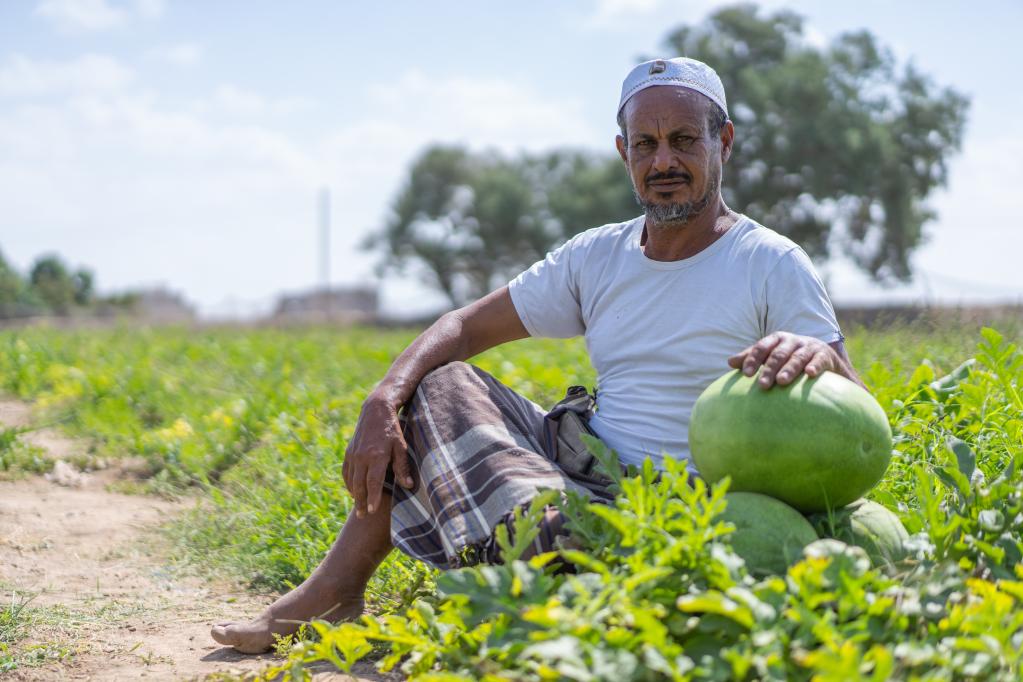
Story
01 July 2025
WHO Yemen: Every Drop Counts: How clean water is restoring hope to Yemen’s hospitals
Aden, Yemen Before the water trucks started arriving, each morning at the hospital began with uncertainty.“We used to check the water tanks before we checked on patients,” says Amal, a nurse at a Khalifa Hospital in Yemen. “If there was no water, we had to rethink everything –sterilization, wound care, even washing hands.”Water, a simple and essential resource, had become increasingly scarce in Yemen’s overburdened health facilities. Without it, health care workers like Amal had to make difficult decisions every day.“You can’t clean an operating room or safely deliver a baby without water,” she says. “But often, no water was a daily reality.”Things began to shift when WHO launched to restore access to safe water in hospitals through “Improved WASH Services in Hospitals with Sustainable Water Supply” project, supported by the King Salman Humanitarian Aid and Relief Centre (KSrelief),to serve the most vulnerable populations in Yemen. With this initiative, 60 health care facilities now receive regular trucks of clean water, allowing to better serve 580,000 people, many of them displaced or living in high-risk areas. A matter of survivalBefore the intervention, water shortages led to critical procedures being postponed and the closure of delivery rooms. Sanitation and basic infection prevention protocols were compromised.“We sometimes had to send patients elsewhere, not because we lacked doctors, but because we had no water,” says Dr. Mohammed, Head of Nursing Department at Taiz Psychiatric Hospital,. “It was painful for everyone involved.”Today, with regular water deliveries and a water quality control system in place, project hospitals can function more reliably. Disinfection routines are followed, surgical wards are active and basic hygiene is no longer a daily struggle.“We’ve regained stability. Staff are less stressed and patients are safer,” says Dr.Mohammed. Delivering more than a waterBehind the scenes are people like Hussein, a water trucking supervisor, who oversees distribution to more than 50 hospitals in 5 governorates.“Every tank we deliver is tested and treated before use,” he explains. “And when a hospital calls to say they’ve received the delivery, we know we’ve helped someone get care they can trust.”There have been challenges along the way, rough roads, occasional contamination and the pressure to meet growing needs. But the impact, Hussein adds, makes it worth it.“Clean water doesn’t just improve services, it protects lives.”New standards of careAmal senses the change in every corner of Khalifa Hospital.“Now we can focus on patient care, not just on coping. We’re able to follow proper hygiene steps and respond quickly in emergencies. That makes a real difference, especially in maternity and surgery.”Infections are down, Staff morale is up, and for the first time in years, patients-and their relatives are expressing satisfaction with the cleanliness and safety of facilities.“Even visitors notice,” says Amal. “People are no longer afraid to come here for service.”Thankful for every drop“Thank you for seeing this need, for responding before things got worse,” says Amal.“This wasn’t just about infrastructure,” adds Mohammed. “It was about restoring dignity and trust to health care in Yemen.”With KSrelief’s fund, safe water has returned to places where hope was fading, and with it, the ability of health care workers to do what they are trained to do. Save lives, safely and with dignity.
1 of 5

Story
29 June 2025
UNFPA Yemen: Boosting Access to Maternal Health: Saves Yemen’s mothers and their babies
Al Hudaydah, Yemen – “I was afraid I wouldn’t survive my pregnancy, but the timely care I received at the health centre saved me and my baby,” tells Zainab, 28, from Al Khokha district. Zainab, pregnant with her fourth child, faced serious childbirth complications. The families’ impoverishment left her severely malnourished and anemic during her entire pregnancy, threatening her life and that of her newborn during childbirth.A health system stretched to its limitA decade of conflict has stretched Yemen’s healthcare system to breaking point. Only one in five of the functioning health facilities is able to provide maternal and child health services. As a result, five million women of childbearing age, including pregnant and lactating women, face challenges accessing health services, especially in rural and frontline districts. This is due to the non-availability of specialized female doctors and nurses, insufficient essential medical supplies, and limited access to services.Over 1.3 million pregnant and breastfeeding women are projected to require treatment for acute malnutrition in 2025. They risk giving birth to newborns with severely stunted growth and nursing malnourished infants due to rising food insecurity.A continuum of careAs Zainab’s complications worsened in her seventh month of pregnancy, she sought care at Al Khokha Health Centre – a vital point for health services in the community, serving more than 150 people a day – supported by UNFPA with the financial assistance of European Union Humanitarian.At the center, Zainab was welcomed by an experienced, all-female medical team. A trained midwife conducted a thorough assessment, provided iron supplements and personalized counseling on hygiene and nutrition.The severity of Zainab’s condition required referral to Hays Rural Hospital – another facility supported by European Union in the area – offering more specialized and surgical care for pregnant women. Zainab also received cash to cover her transportation cost, a cost she could not afford. This helped to ensure her safe and timely access to advanced medical care.At Hays Hospital, Zainab underwent a caesarean section, delivering safely.Later, Zainab returned to the Al Khokha Center for postnatal care, participating in sessions for breastfeeding and family planning that helped to strengthening her ability to care for herself and her newborn.Zainab’s husband, who has previously been hesitant to seek skilled care during childbirth for his wife has now become a strong advocate, actively encouraging other men in the village to obtain these services at health facilities for their wives. The impact of this continuum of care was profound. Zainab recovered fully and avoided life-threatening complications and was empowered with the knowledge to safeguard her health, her families and the community at large.Partnerships saving lives Zainab story could have ended in tragedy but became a story of survival, resilience, and community transformation by ensuring access and availability to coordinated health services, fueled through the strong partnership of UNFPA and the European Union.With the support of European Union, UNFPA provides emergency obstetric and maternal health care in 52 health facilities across Yemen. This support since 2018, has been pivotal to address the maternal health of millions of women and girls and save thousands of women’s lives during childbirth.
1 of 5
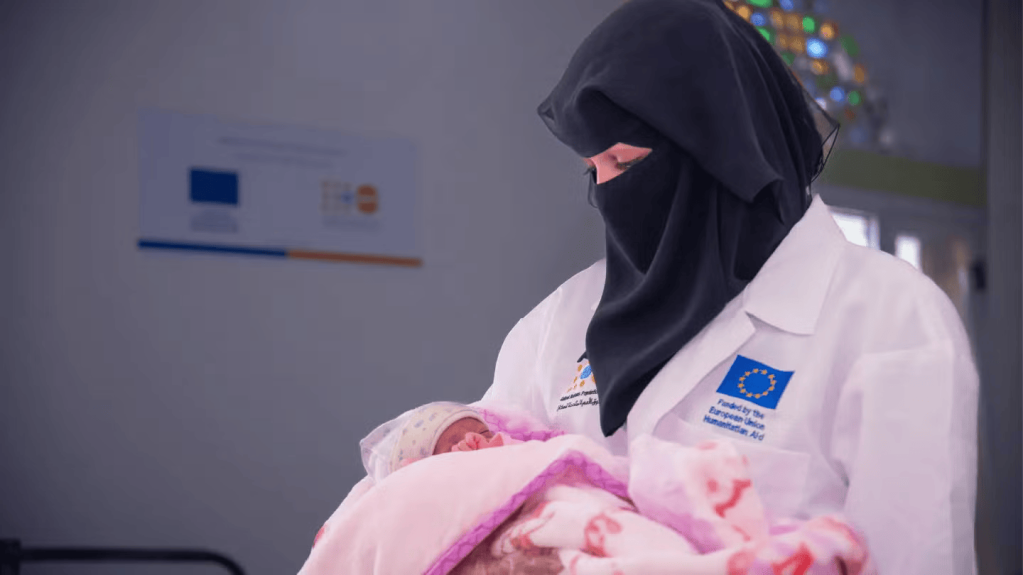
Story
28 June 2025
UNDP Yemen: Women propel local economic development in Marib, Yemen
In Yemen, years of conflict have severely degraded critical infrastructure. This has placed considerable strain on businesses and entrepreneurs - key providers of employment and livelihoods - as they struggle with damaged facilities and continuous disruptions across essential value chains. State institutions play a vital role in shaping an environment that enables businesses to function, expand, and innovate. Their capacity to attract investment, rehabilitate infrastructure, and support local entrepreneurs is essential to driving recovery and fostering sustainable economic development.
Millions in Yemen are internally displaced, and amid the ongoing displacement crisis, Marib’s growing population is putting pressure on local services and infrastructure. In response, local authorities, with support from UNDP’s Strengthening Institutional and Economic Resilience in Yemen (SIERY) Project, are working to strengthen service delivery and urban planning. As part of these efforts, the restoration of key infrastructure, including schools, technical and vocational training centres, and roads, is helping to restore the foundation for economic growth and future investment.In parallel, the project’s Local Economic Development (LED) package is supporting governorate and district authorities’ efforts to promote local enterprises, with a particular attention on the sesame value chain. This focus draws on Marib Governorate’s long-standing role in sesame cultivation, owing to its favourable soil and climate conditions. Building on the outcomes of discussions and the recommendations of a value chain analysis carried out by the SIERY Project, local authorities began working with technical experts to address the identified gaps. To date, hundreds of business consultants, agricultural engineers, and small and medium-sized enterprises have been trained and supported to bring about the revitalisation of the sesame sector. Among the targeted interventions, a group of 80 women received specialised training in value-added sesame processing. The aim was to equip participants with practical skills and encourage women-led entrepreneurship within the local economy. The curriculum included modules on food processing, sesame oil extraction, soap and scrub making, sesame paste (tahini) production, branding, packaging, and foundational business skills. The programme sought not only to diversify the use of locally grown sesame but also to create new income-generating opportunities. Sara, a young woman displaced by conflict and now the main provider for her family of seven, shared: “I had always wanted to learn how to make different products using sesame seeds, but I never had the chance to do so.”“This training helped me learn how to extract oil from sesame, and how to make tahini and soap. The course also gave me confidence to start my own small business to support my family and offer high-quality local products to the community,” she added. “I believe that I need to be a productive member of my society and make positive contributions within my community. This training opened new doors for me. I learned how to use sesame to make different products. We also took a course on branding, which helped us understand how to present our products in a professional way that appeals to customers,” shared Shaimaa.
Shaimaa has already started making products at home and her business is growing step by step. “My business is allowing me to earn an income, support my family, and meet market demand for quality sesame products.” Fatima, a mother of three, also reflects on her experience during the training. “I had a real interest in learning how to make these kinds of products but didn’t know where to start,” she said.
“One of the advantages for me is that we are using locally grown sesame, rather than relying on imported raw materials. I’ve already started making soaps and creams at home, and the response has been very positive,” added Fatima. Local authorities organised a community bazaar in a public park, giving training participants the opportunity to showcase their products, connect with customers, and generate income. Made possible thanks to the European Union.
Millions in Yemen are internally displaced, and amid the ongoing displacement crisis, Marib’s growing population is putting pressure on local services and infrastructure. In response, local authorities, with support from UNDP’s Strengthening Institutional and Economic Resilience in Yemen (SIERY) Project, are working to strengthen service delivery and urban planning. As part of these efforts, the restoration of key infrastructure, including schools, technical and vocational training centres, and roads, is helping to restore the foundation for economic growth and future investment.In parallel, the project’s Local Economic Development (LED) package is supporting governorate and district authorities’ efforts to promote local enterprises, with a particular attention on the sesame value chain. This focus draws on Marib Governorate’s long-standing role in sesame cultivation, owing to its favourable soil and climate conditions. Building on the outcomes of discussions and the recommendations of a value chain analysis carried out by the SIERY Project, local authorities began working with technical experts to address the identified gaps. To date, hundreds of business consultants, agricultural engineers, and small and medium-sized enterprises have been trained and supported to bring about the revitalisation of the sesame sector. Among the targeted interventions, a group of 80 women received specialised training in value-added sesame processing. The aim was to equip participants with practical skills and encourage women-led entrepreneurship within the local economy. The curriculum included modules on food processing, sesame oil extraction, soap and scrub making, sesame paste (tahini) production, branding, packaging, and foundational business skills. The programme sought not only to diversify the use of locally grown sesame but also to create new income-generating opportunities. Sara, a young woman displaced by conflict and now the main provider for her family of seven, shared: “I had always wanted to learn how to make different products using sesame seeds, but I never had the chance to do so.”“This training helped me learn how to extract oil from sesame, and how to make tahini and soap. The course also gave me confidence to start my own small business to support my family and offer high-quality local products to the community,” she added. “I believe that I need to be a productive member of my society and make positive contributions within my community. This training opened new doors for me. I learned how to use sesame to make different products. We also took a course on branding, which helped us understand how to present our products in a professional way that appeals to customers,” shared Shaimaa.
Shaimaa has already started making products at home and her business is growing step by step. “My business is allowing me to earn an income, support my family, and meet market demand for quality sesame products.” Fatima, a mother of three, also reflects on her experience during the training. “I had a real interest in learning how to make these kinds of products but didn’t know where to start,” she said.
“One of the advantages for me is that we are using locally grown sesame, rather than relying on imported raw materials. I’ve already started making soaps and creams at home, and the response has been very positive,” added Fatima. Local authorities organised a community bazaar in a public park, giving training participants the opportunity to showcase their products, connect with customers, and generate income. Made possible thanks to the European Union.
1 of 5
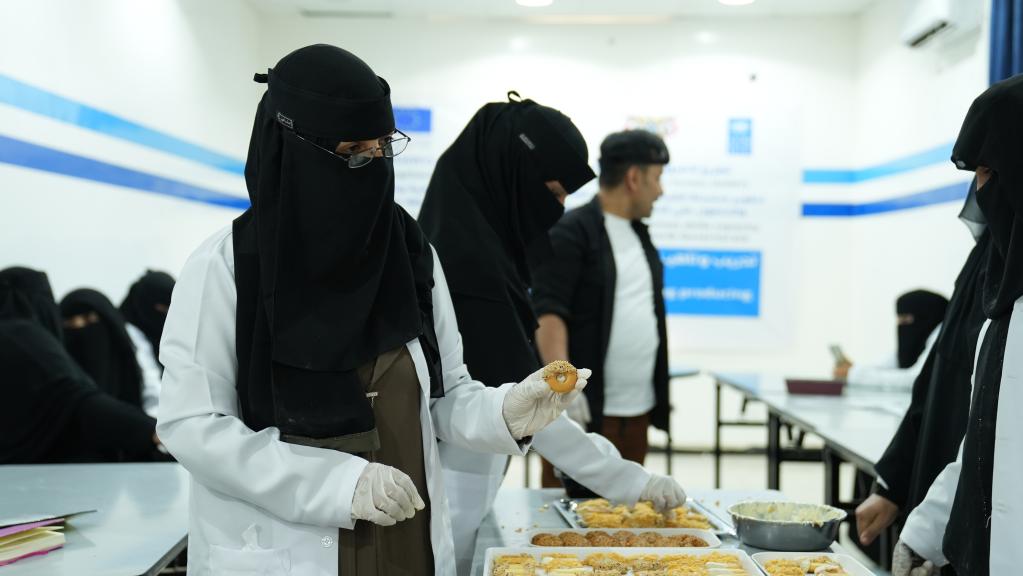
Story
16 June 2025
UNICEF Yemen: Transformation of School, From a neglected place to a place where dreams can be made true
Two years ago, 12-year-old Qamar dropped out of Al-Saadah School because the school was two hours far on foot. The nearest school from her, Aisha School, had been abandoned since 2014 because of the armed conflict in Yemen.During all this time she has hoped that she could go back to school one day."I stopped going to school because it was too far away," says Qamar. "Every day, I miss going to school. I want to study, meet my teachers, attend classes and meet my colleagues.In Yemen, an estimated 3.7 million school-age children remain out of school,[1] with the education infrastructure severely damaged and teachers unpaid since 2016, leading to a debilitating teacher exodus. The education disruption not only hampers children’s academic progress but also threatens their cognitive and emotional development.While she was not in school, Qamar had nothing to do during this time but to stay at home and help her mother at home. She always wondered when she would go back to school. Limited and unsuitable options for childrenBadriya Ahmed, Aisha School Principal said that the only option available to children who wanted to go to school was to walk for long hours under the sun to reach the nearest school. Others just dropped out of school.“When Aisha School was destroyed, many students dropped out of the school. Some children went for work as shepherds, some girls were married off, and other students moved to other schools far from their homes,” said Badriya.Badriya explained that the long distance was an issue for the children, especially girls. Many of them would fall sick due to walking under the scorching noon sun for a long time. She added that “families are poor and cannot afford transportation fees for their children”.Hope is restoredTo help more than 500,000 students in Yemen go back to learning, UNICEF works to support the education system through rehabilitation of schools, training teachers, providing learning kits for schools and school items to children. Luckily, in 2024, Aisha School was among 1,171 schools that received minor or major rehabilitation.Aisha School in Al-Jawf, has received major rehabilitation in 2024 thanks to support from UNICEF and funding from the German Federal Government through KfW Development Bank. The transformation of the school from negligence to a clean, neat and bright place is the first step to make dreams come true.The rehabilitation of Aisha school made Qamar happy and eager to look forward to a bright future. She is 12 today and is excited that she finally will go back to school!"I hope we achieve my dreams, excel and become top students. I hope to major in medicine at university."[1] UNICEF, 2024 MICS-EAGLE Yemen Education Fact Sheets, 2024.
1 of 5
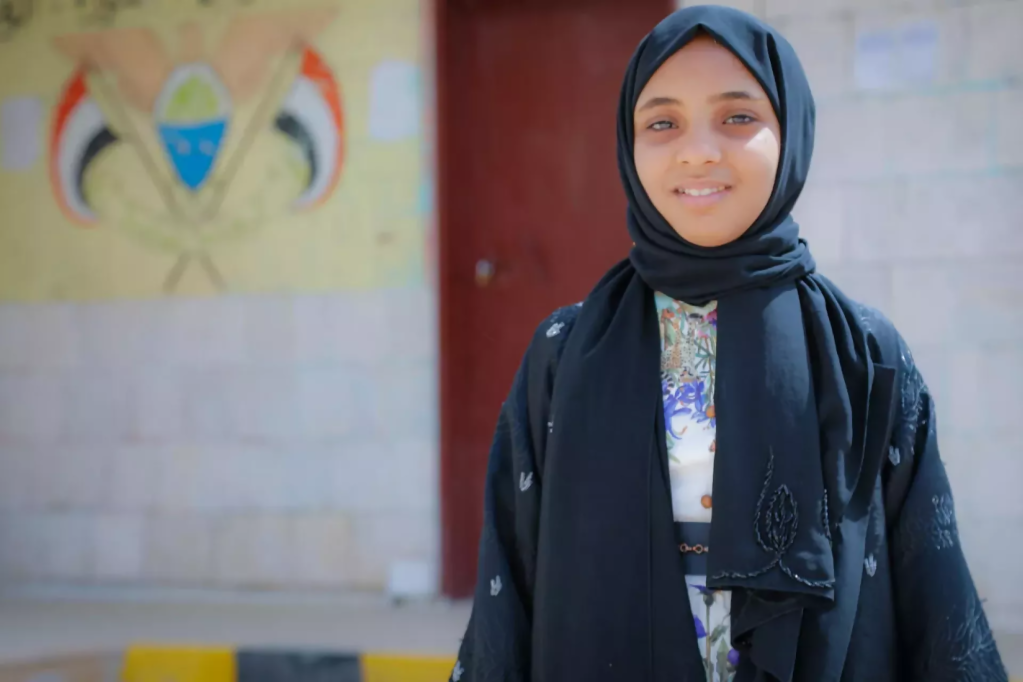
Press Release
12 July 2025
WHO and UNICEF launch polio vaccination campaign targeting over 1.3 million children in Government of Yemen-controlled areas
12 July 2025, Aden, Yemen A new round of polio vaccination for children begins this week in Government of Yemen-controlled areas. The 3-day campaign, running from 12 to 14 July 2025, aims to boost population immunity in high-risk areas and prevent further spread of the virus by administering novel oral polio vaccine type 2 (nOPV2) to more than 1.3 million children in 120 districts across 12 governorates. The intervention comes in response to cases in the community and the continued confirmed circulation of variant type 2 poliovirus (cVDPV2) in environmental samples.“Yemen remains at high risk for poliovirus outbreaks due to protracted conflict, weakened health systems and low routine immunization coverage,” said Acting WHO Representative in Yemen Dr Ferima Coulbibaly-Zerbo. “With poliovirus continuing to circulate and cases confirmed in 2025, these campaigns are essential to interrupt transmission and protect every child from the debilitating effects of polio.”
Since 2021, Yemen has reported a total of 282 cVDPV2 cases across 122 districts in 19 of the country’s 22 governorates, with 98% of cases occurring in children under the age of 5. The overall epidemiological trend highlights the urgent need for nOPV-2 vaccine to halt cVDPV circulation in government-controlled governorates and protect children from the disease.The campaign is led by the Ministry of Public Health and Population (MoPHP) with support from World Health Organization (WHO) and UNICEF and the Global Polio Eradication Initiative (GPEI).It will be carried out by almost 7,000 vaccination teams, including over 6,000 mobile door-to-door teams and 800 teams at health facilities. Nearly 2,000 team supervisors and 240 district-level supervisors will oversee the campaign, with technical support from national and partner agencies.“The campaign is an important and urgent step to protect children from being paralysed by the poliovirus. With confirmed cases of polio among Yemeni children, an imminent threat persists, especially for every unvaccinated child. But, through vaccination, we can keep our children safe,” said Peter Hawkins, UNICEF Representative to Yemen.WHO and UNICEF, as core partners of GPEI, are fully committed to supporting the Government of Yemen in its efforts to eradicate polio and strengthen routine immunization services. Continued investment and coordinated action are essential to ensure no child is left behind.
###About WHO
Since 1948, the World Health Organization (WHO) has been the United Nations agency dedicated to advancing health for all, so that everyone, everywhere can attain the highest level of health. WHO leads global efforts to expand universal health coverage, direct and coordinate the world’s responses to health emergencies and connect nations, partners and people to promote health, keep the world safe and serve the vulnerable.About UNICEF
UNICEF works in some of the world’s toughest places, to reach the world’s most disadvantaged children. Across more than 190 countries and territories, we work for every child, everywhere, to build a better world for everyone. For more information about UNICEF and its work for children visit http://www.unicef.org/yemen Media contactsWHO Yemen: mediayemen@who.int
UNICEF Yemen: yemenmedia@unicef.org
Since 2021, Yemen has reported a total of 282 cVDPV2 cases across 122 districts in 19 of the country’s 22 governorates, with 98% of cases occurring in children under the age of 5. The overall epidemiological trend highlights the urgent need for nOPV-2 vaccine to halt cVDPV circulation in government-controlled governorates and protect children from the disease.The campaign is led by the Ministry of Public Health and Population (MoPHP) with support from World Health Organization (WHO) and UNICEF and the Global Polio Eradication Initiative (GPEI).It will be carried out by almost 7,000 vaccination teams, including over 6,000 mobile door-to-door teams and 800 teams at health facilities. Nearly 2,000 team supervisors and 240 district-level supervisors will oversee the campaign, with technical support from national and partner agencies.“The campaign is an important and urgent step to protect children from being paralysed by the poliovirus. With confirmed cases of polio among Yemeni children, an imminent threat persists, especially for every unvaccinated child. But, through vaccination, we can keep our children safe,” said Peter Hawkins, UNICEF Representative to Yemen.WHO and UNICEF, as core partners of GPEI, are fully committed to supporting the Government of Yemen in its efforts to eradicate polio and strengthen routine immunization services. Continued investment and coordinated action are essential to ensure no child is left behind.
###About WHO
Since 1948, the World Health Organization (WHO) has been the United Nations agency dedicated to advancing health for all, so that everyone, everywhere can attain the highest level of health. WHO leads global efforts to expand universal health coverage, direct and coordinate the world’s responses to health emergencies and connect nations, partners and people to promote health, keep the world safe and serve the vulnerable.About UNICEF
UNICEF works in some of the world’s toughest places, to reach the world’s most disadvantaged children. Across more than 190 countries and territories, we work for every child, everywhere, to build a better world for everyone. For more information about UNICEF and its work for children visit http://www.unicef.org/yemen Media contactsWHO Yemen: mediayemen@who.int
UNICEF Yemen: yemenmedia@unicef.org
1 of 5
Press Release
01 July 2025
The Water authorities of Taiz agree to cooperate across front line, Yemen Humanitarian Fund supports
Taiz, Yemen, 01 July 2025The Local Water and Sanitation Corporations (LWSC) in Taiz City and Al-Hawban have reached a technical agreement to jointly manage water supply systems - a step forward in restoring essential services in one of Yemen’s most water-stressed governorates, bringing relief to hundreds of thousands of people. This agreement would result in reconnecting water and sewage networks in Taiz Governorate, restoring essential services that have been disrupted for nearly a decade due to conflict and institutional fragmentation.The agreement builds on the sustained efforts of many organizations and donors who have contributed technically, financially, and through facilitation over the years. Key contributors include the Governments of Germany and the Netherlands, Generation without Qat, Humanitarian Development Program, CARE, OXFAM, Human Access, the Yemen Family Care Association, a number of UN agencies operating in Yemen, and others.To accelerate the availability of safe water in priority areas, the Yemen Humanitarian Fund (YHF) is investing 2 million USD to connect 90,000 of people including internally displaced persons (IDPs) to water networks, helping transition them out of humanitarian need and toward longer-term development.The United Nations commends the leadership of the water authorities in Taiz and calls on donors and partners to step up investments in water infrastructure to ensure over 600,000 people can access safe, reliable water and sewage systems.
1 of 5
Press Release
22 June 2025
Joint Press Release – FAO, WFP and UNICEF: Acute food insecurity deepens in the Government-controlled areas of Yemen amid severe funding cuts and economic downturn
Aden, 22 June 2025 – The food security situation in the Government-controlled areas of southern Yemen is dire, with nearly half of the population acutely food insecure and struggling to find their next meal. The Food and Agriculture Organization of the United Nations (FAO), World Food Programme (WFP), and UNICEF have warned that the food insecurity crisis is likely to worsen in the months ahead. The latest Integrated Food Security Phase Classification (IPC) partial update, released today, paints a grim picture for southern governorates. Between May 2025 and August 2025, around 4.95 million people are facing Crisis-level food insecurity or worse (IPC Phase 3+), including 1.5 million in Emergency (IPC Phase 4). This marks an increase of 370,000 people suffering from severe food insecurity compared to the period November 2024 to February 2025.Looking ahead, the situation is expected to deteriorate even further. Between September 2025 and February 2026, an additional 420,000 people could fall into IPC Phase 3 or worse, if urgent and sustained assistance is not provided. That would bring the total number of severely food-insecure people in southern governorate areas to 5.38 million—more than half of the population.Multiple overlapping crises continue to drive food insecurity, including sustained economic decline, currency depreciation in southern governorates, conflict, and increasingly severe weather events. The delayed planting season, heightened likelihood of flood risk in July, and the spread of plant and livestock diseases, especially desert locusts, are further expected to compound pressures on an already fragile situation.Humanitarian actors including UNICEF, WFP, and FAO are reprioritizing their humanitarian efforts in Yemen, targeting high-risk areas with integrated interventions in food security, nutrition, WASH, health and protection sectors to maximize lifesaving impact.“The fact that more and more people in Yemen don’t know where their next meal will come from is extremely concerning at a time when we are experiencing unprecedented funding challenges,” said Siemon Hollema, the Deputy Country Director of WFP in Yemen. “Immediate support is needed to ensure that we can continue to serve the most vulnerable families that have nowhere else to turn.”The agencies are urgently calling for sustained and at-scale humanitarian and livelihoods support assistance to prevent communities from falling deeper into food insecurity, ensure access to essential services and generate economic and livelihood opportunities. Dr. Hussein Gadain, FAO Representative in Yemen, emphasized, "The situation is dire and requires urgent intervention, with agriculture holding the key to ending Yemen’s food insecurity crisis. Further, delayed and insufficient rainfall in April has cast a shadow over the current planting season, threatening the already fragile farming livelihoods and food availability. With urgent support, we can revitalize local food production, safeguard livelihoods, and move from crisis to resilience building ensuring, efficiency and effectiveness."Internally displaced persons, low-income rural households and vulnerable children are particularly affected, facing increased vulnerability due to funding cuts, declining livelihood opportunities, and reduced coping mechanisms.Peter Hawkins, UNICEF Representative to Yemen, highlighted that “Approximately 2.4 million children under the age of five and 1.5 million pregnant and lactating women suffer from acute malnutrition in Yemen, placing them at greater risk of illness, developmental delays, and death.” “The IPC nutrition data suggests further deterioration in at least 5 out of 17 of the livelihood zones in IRG areas, so UNICEF and partners are making provisions to scale up intervention which needs to be sustained if we are going to overcome the crisis,” added Peter Hawkins. ------End-----About FAO: The Food and Agriculture Organization (FAO) is a specialized agency of the United Nations that leads international efforts to defeat hunger. Our goal is to achieve food security for all and make sure that people have regular access to high-quality food to lead active, healthy lives. With over 194 members, FAO works in over 130 countries worldwide.Follow FAO Yemen on X for more: @FAOYemenAbout the United Nations World Food Programme (WFP): WFP is the world’s largest humanitarian organization, saving lives in emergencies and using food assistance to build a pathway to peace, stability, and prosperity for people recovering from conflict and disasters. Follow us on Twitter @WFPYemenAbout UNICEF:
UNICEF promotes the rights and wellbeing of every child, in everything we do. Together with our partners, we work in 190 countries and territories to translate that commitment into practical action, focusing special effort on reaching the most vulnerable and excluded children, to the benefit of all children, everywhere.For more information about UNICEF Yemen and its work for children, visit www.unicef.org/yemenFollow UNICEF Yemen on X, Facebook, Instagram and YouTubeMedia contacts:FAO: Evani Debone, evani.debone@fao.org WFP: Cheyenne Curley, cheyenne.curley@wfp.org UNICEF: Kamal Al-Wazizah, kalwazizah@unicef.org
UNICEF promotes the rights and wellbeing of every child, in everything we do. Together with our partners, we work in 190 countries and territories to translate that commitment into practical action, focusing special effort on reaching the most vulnerable and excluded children, to the benefit of all children, everywhere.For more information about UNICEF Yemen and its work for children, visit www.unicef.org/yemenFollow UNICEF Yemen on X, Facebook, Instagram and YouTubeMedia contacts:FAO: Evani Debone, evani.debone@fao.org WFP: Cheyenne Curley, cheyenne.curley@wfp.org UNICEF: Kamal Al-Wazizah, kalwazizah@unicef.org
1 of 5
Press Release
22 June 2025
FAO Yemen: FAO Hosts Technical Workshop with key stakeholders to Enhance Watershed Management in Wadi Hajr
Mukalla, Yemen – 22 June 2025 The Food and Agriculture Organization of the United Nations (FAO), in collaboration with the Ministry of Agriculture, Irrigation and Fisheries (MAIF), the Ministry of Water and Environment (MWE), and the Netherlands Embassy, hosted a hybrid technical workshop in Mukalla, Hadhramaut Governorate. This engaging workshop presented findings from crucial baseline studies conducted by Acacia B.V. and Wageningen University to advance effective watershed management in the Wadi Hajr region under the "Sustainable Watershed Management through Reinforced Governance, Resilience, and Regenerative Agriculture in Wadi Hajr project that is funded by the Netherlands Embassy with support from the Government of France. Been a vital agricultural area in Yemen, Wadi Hajr is the only Yemeni wadi that has a baseflow round the year. The region experiences an arid to semi-arid climate, with annually varying rainfall and high-water loss due to evaporation. The Wadi is essential for sustaining local agriculture, which is the main livelihood for local communities in the region.
Key findings from the studies indicated that the cultivable presents opportunity for agriculture predominantly for dates palm, vegetables and cereals utilizing traditional spate irrigation methods. However, the region faces significant challenges, including deteriorating irrigation systems and the urgent need to rehabilitate large to medium infrastructure of over 30 spread along the Wadi and over 500 smaller ones while considering storage facility provision. Additionally, extreme weather events, with a projected increase in temperature that are expected to heighten flash floods, leading to population displacement and disruption of agricultural activities.
Farmers are utilizing merely 10% of the available surface flow due to damaged irrigation infrastructure and a lack of large storage infrastructure to prevent flash floods waters that currently flow downstream to the sea. Existing crops primarily include sorghum, millet, and wheat, with date palms serving as the main cash crop, requiring improved marketing strategies. Studies also reveal the potential for highland wheat expansion, while further assessment is needed for wheat production feasibility in the floodplains due to rising temperatures.
Further, the findings highlighted critical community needs, including improved water management through enhanced irrigation systems and urgent infrastructure rehabilitation to reduce flood risks. There is also a pressing demand for equitable access to land and water resources, especially for women facing barriers to ownership and rights. Additionally, communities require training and support to adopt sustainable farming practices, boost crop productivity, and implement climate adaptation strategies to safeguard agricultural livelihoods against worsening environmental challenges.
The ongoing project, "Sustainable Watershed Management through Reinforced Governance, Resilience, and Regenerative Agriculture in Wadi Hajr," is already addressing some pressing needs by initiating improvements in irrigation systems and infrastructure rehabilitation. A joint Wadi Hajar development effort from the governments of the Netherlands and France has been a key partnership in developing the area.
The workshop gathered national stakeholders, local government officials, technical experts, civil society leaders, and international donors to discuss the findings and develop actionable strategies. Emphasis was placed on the importance of equitable access to land and water, particularly concerning gender issues in land tenure. Women often face limitations regarding land ownership and access to resources, highlighting the necessity for inclusive policies.
Dr. Hussein Gadain, FAO Yemen Representative, stated, "This workshop marks a milestone in our joint efforts for inclusive management of the scare land and water resources in Yemen for achieving food security and transforming agrifood systems for the better life of the people of Yemen. Let's engage openly and strengthen our roadmap for transforming Wadi Hajr into a productive landscape."During the workshop also it was also emphasized that there is an ongoing collaboration with the Netherlands and the World Bank to improve climate and water information management in the region through developing a framework for wider information management system for the country. This system aims to improve decision-making for local authorities by providing real-time data on climate and water resources, facilitating better resource allocation and adaptation strategies.
This partnership aims to leverage the findings from recent studies to support informed decision-making for sustainable development in Wadi Hajr and other parts of the country.
As the workshop concluded, there was a strong commitment among participants to seek additional funding to extend interventions throughout Wadi Hajr. The Netherlands government is initiating funding for the establishment of the new Wadi Hajr Development Committee to prepare investment plans that will further enhance agricultural productivity and community resilience.
Key findings from the studies indicated that the cultivable presents opportunity for agriculture predominantly for dates palm, vegetables and cereals utilizing traditional spate irrigation methods. However, the region faces significant challenges, including deteriorating irrigation systems and the urgent need to rehabilitate large to medium infrastructure of over 30 spread along the Wadi and over 500 smaller ones while considering storage facility provision. Additionally, extreme weather events, with a projected increase in temperature that are expected to heighten flash floods, leading to population displacement and disruption of agricultural activities.
Farmers are utilizing merely 10% of the available surface flow due to damaged irrigation infrastructure and a lack of large storage infrastructure to prevent flash floods waters that currently flow downstream to the sea. Existing crops primarily include sorghum, millet, and wheat, with date palms serving as the main cash crop, requiring improved marketing strategies. Studies also reveal the potential for highland wheat expansion, while further assessment is needed for wheat production feasibility in the floodplains due to rising temperatures.
Further, the findings highlighted critical community needs, including improved water management through enhanced irrigation systems and urgent infrastructure rehabilitation to reduce flood risks. There is also a pressing demand for equitable access to land and water resources, especially for women facing barriers to ownership and rights. Additionally, communities require training and support to adopt sustainable farming practices, boost crop productivity, and implement climate adaptation strategies to safeguard agricultural livelihoods against worsening environmental challenges.
The ongoing project, "Sustainable Watershed Management through Reinforced Governance, Resilience, and Regenerative Agriculture in Wadi Hajr," is already addressing some pressing needs by initiating improvements in irrigation systems and infrastructure rehabilitation. A joint Wadi Hajar development effort from the governments of the Netherlands and France has been a key partnership in developing the area.
The workshop gathered national stakeholders, local government officials, technical experts, civil society leaders, and international donors to discuss the findings and develop actionable strategies. Emphasis was placed on the importance of equitable access to land and water, particularly concerning gender issues in land tenure. Women often face limitations regarding land ownership and access to resources, highlighting the necessity for inclusive policies.
Dr. Hussein Gadain, FAO Yemen Representative, stated, "This workshop marks a milestone in our joint efforts for inclusive management of the scare land and water resources in Yemen for achieving food security and transforming agrifood systems for the better life of the people of Yemen. Let's engage openly and strengthen our roadmap for transforming Wadi Hajr into a productive landscape."During the workshop also it was also emphasized that there is an ongoing collaboration with the Netherlands and the World Bank to improve climate and water information management in the region through developing a framework for wider information management system for the country. This system aims to improve decision-making for local authorities by providing real-time data on climate and water resources, facilitating better resource allocation and adaptation strategies.
This partnership aims to leverage the findings from recent studies to support informed decision-making for sustainable development in Wadi Hajr and other parts of the country.
As the workshop concluded, there was a strong commitment among participants to seek additional funding to extend interventions throughout Wadi Hajr. The Netherlands government is initiating funding for the establishment of the new Wadi Hajr Development Committee to prepare investment plans that will further enhance agricultural productivity and community resilience.
1 of 5
Press Release
17 June 2025
IOM Constructs Climate-Resilient Bridge to Improve Access to Thousands of People in Ibb Governorate
Ibb, Yemen – Amid the growing challenges of climate change and its impact on communities, the International Organization for Migration (IOM) has successfully completed the construction of a large-scale pedestrian bridge in the Dhi Al-Sufal District of Ibb Governorate with support from the EU Humanitarian Aid. The bridge aims to provide safe access for communities often cut off from services due to floods and erratic weather patterns. “Climate change is transforming the way people in Yemen live, and our response must adapt to these changing realities,” said Abdusattor Esoev, IOM’s Chief of Mission in Yemen. “The construction of this bridge is part of IOM’s broader strategy to build resilience against the increasing frequency of extreme weather events, including floods and cyclones, which have devastating impacts on vulnerable populations.” Extreme weather events have been on the rise in Yemen, with floods affecting over 1.3 million people in 2024, marking a 61% increase from the previous year. These floods often cause widespread destruction of infrastructure, homes, roads, and water systems, while also undermining food security and livelihoods. By building this climate-resilient bridge, IOM is directly addressing these vulnerabilities — enhancing safe access to healthcare, education, markets, and water sources, while helping communities adapt to increasing climate threats. The bridge spans 30 meters in length and 1.6 meters in width and was constructed over 45 days. Designed to withstand Yemen’s unpredictable rainfall and intensifying storms, it ensures reliable passage even during heavy rains and floods. More than 7,800 individuals — including 800 displaced people and 7,000 host community members — will benefit from this project. Prior to its construction, local communities, especially women and children, faced significant challenges crossing the area during the rainy season, often finding themselves cut off from schools, health services, and markets. “Constructing infrastructure that can survive the forces of nature is crucial to ensuring the continuity of services that people rely on every day,” said Abdusattor Esoev. “This project not only improves the safety and mobility of displaced and host communities but also demonstrates the importance of integrating climate resilience into humanitarian work.” The intervention was completed through effective coordination between IOM, local authorities, and the community. It was officially handed over in the presence of representatives from the local authorities and the relevant humanitarian coordination bodies.
“This bridge has spared us a great deal of hardship, especially during heavy floods. Before it was built, we couldn’t reach the other side during the rainy season. "Now, thanks to this intervention, our children can cross safely year-round,” explained Mohammed Anber, a local father in Dhi Al-Sufal. This project marks a significant step forward in improving infrastructure and ensuring safer mobility for vulnerable populations in flood-prone areas. It reflects IOM’s broader commitment to addressing climate impacts through sustainable, community-centered solutions. For more information, please contact: IOM Yemen’s Communications Team: iomyemenmediacomm@iom.int
“This bridge has spared us a great deal of hardship, especially during heavy floods. Before it was built, we couldn’t reach the other side during the rainy season. "Now, thanks to this intervention, our children can cross safely year-round,” explained Mohammed Anber, a local father in Dhi Al-Sufal. This project marks a significant step forward in improving infrastructure and ensuring safer mobility for vulnerable populations in flood-prone areas. It reflects IOM’s broader commitment to addressing climate impacts through sustainable, community-centered solutions. For more information, please contact: IOM Yemen’s Communications Team: iomyemenmediacomm@iom.int
1 of 5
Latest Resources
1 / 11
Resources
18 December 2024
1 / 11


